Pompeii -- the City
For a fairly comprehensive set po images of Pompeii,
Herculanum, and surrounding ancient
towns and villas, see
http://www.pompeiiinpictures.com/pompeiiinpictures/index.htm
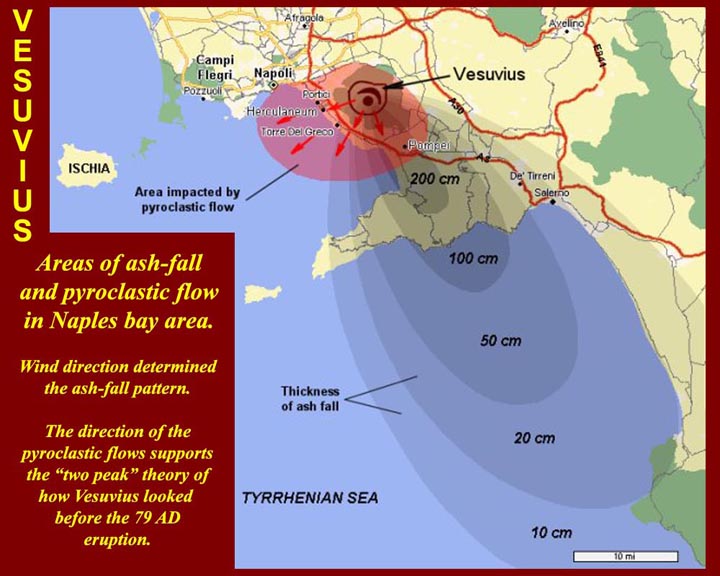
http://www.mmdtkw.org/ALRIVes0301VesEruption79ad.jpg
Pompeii was buried under ash and ignimbrite during the 79
AD eruption. Estimates of current inhabitation of the "red
zone" of any future eruption approximately the same as the
79 AD red zone is about 1.7 million persons. Families
living closest to the volcano can receive up to 35,000 dollars
if they move out, and several thousand families have already
accepted the offer. Current evidence indicates that there
is a pool of 600 cubic kilometers of magma about 1.5 kilometers
below the large caldera which encompasses the Campi Flegrei, the
Bay of Naples, and Vesuvius.
The Great Pompeii Project (2014-21)-- first
new excavations in Pompeii in 70 years
All of the images in the first part of
this lesson were released with great fanfare in an effort to
recommence tourism in the area.
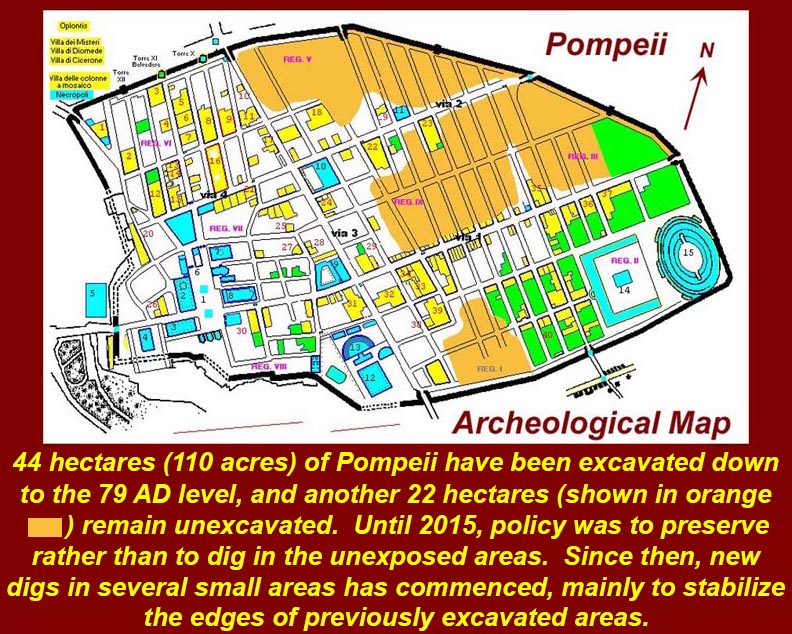
http://www.mmdtkw.org/ALRIVes0300aaPompeiiExcavMap.jpg
One third of Pompeii has never been excavated (orange areas in
the map above). Until 2014 there had been no new
excavations in Pompeii for more than 70 years/
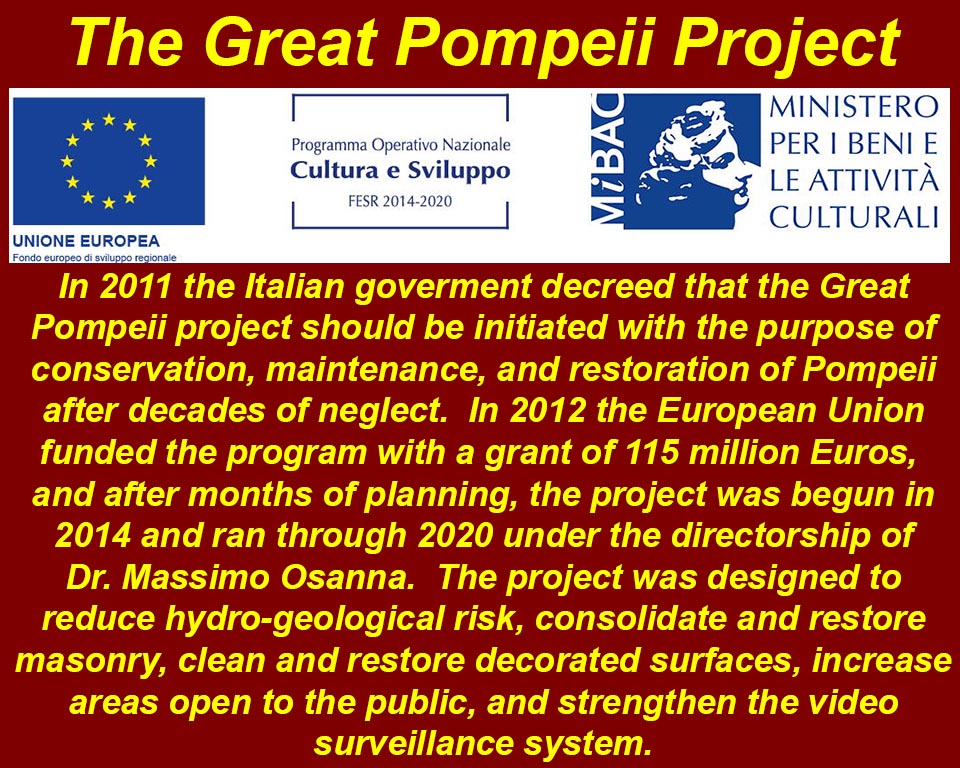
http://www.mmdtkw.org/ALRIVes0300abreatPompeiiProject.jpg
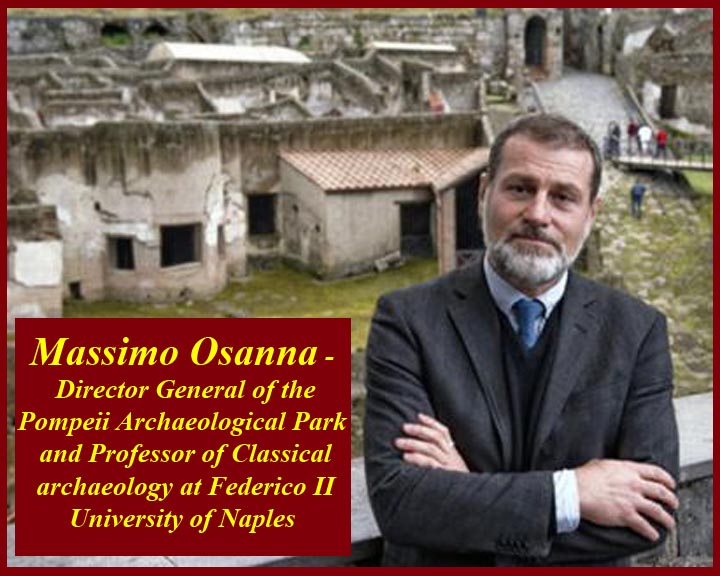
http://www.mmdtkw.org/ALRIVes0300acMassimoOsanna.jpg
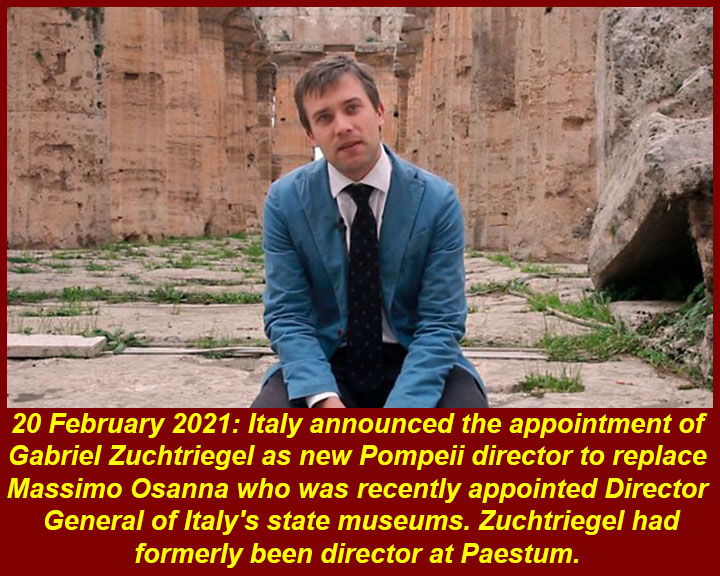
http://www.mmdtkw.org/AlriVes0300adGabZuchtriegel.jpg
Dr. Zuchtriegel was a protege of Dr.Osanna in the early days of
the Great Pompeii Project before being appointed to head the
excavations at Paestum. He is an expert in modern
archeologocal practices, and while in Paestum he led the
discovery of a fourth Greek temple using remote
sencing technology. It is yet to be determined if that
temple will be excavated.
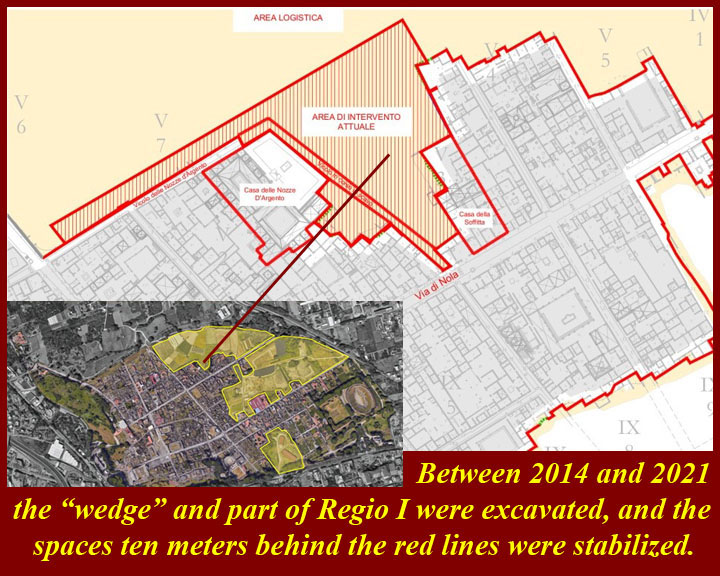
http://www.mmdtkw.org/ALRIVes0300adWedgeMap.jpg
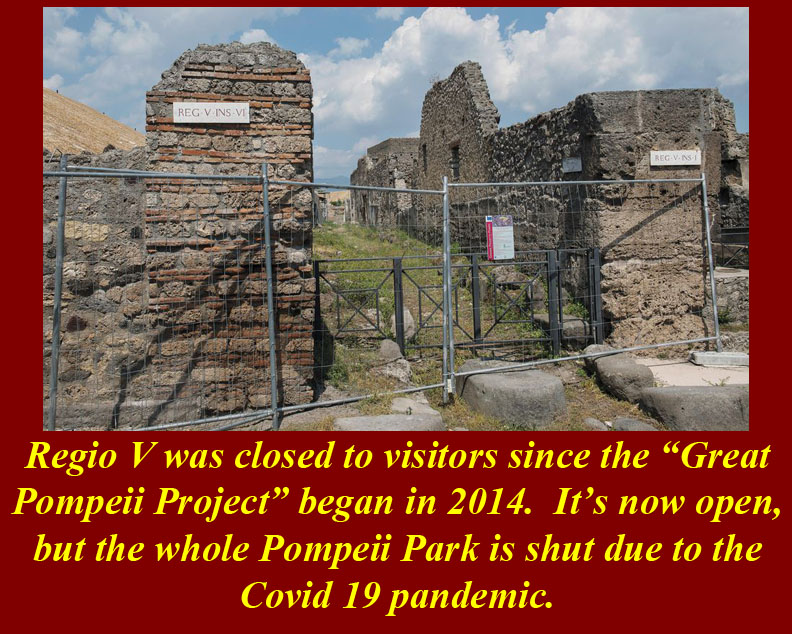
http://www.mmdtkw.org/ALRIVes0300bRegVClosed.jpg
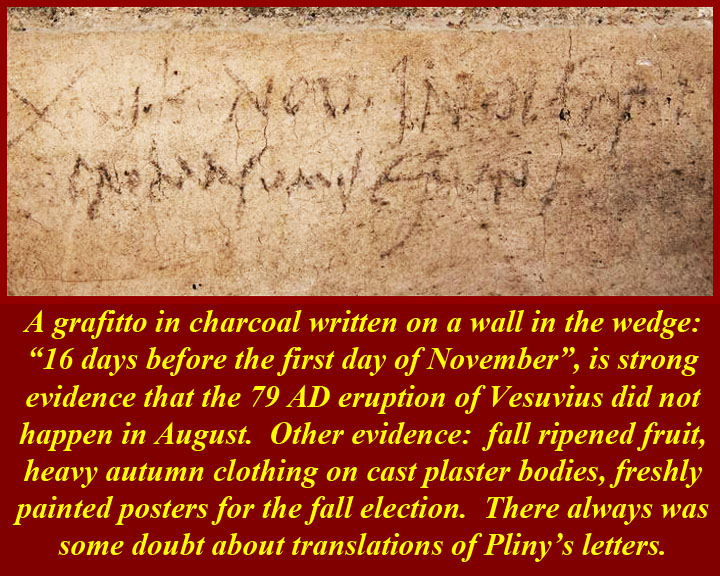
http://www.mmdtkw.org/ALRIVes0300cOctEruptionEvidence.jpg
From a historical point of view, this graffito is perhaps the
most importaant find of the Great Pompeii Project. The
facts of the eruption, destruction, and eventual excavation of
Pompeii and other sites around Vesuvius have not changed -- this
find clarifies the date of the eruption and points to a probable
error in the historical record based on the letters of Pliny the
Younger to the Roman historian Tacitus.
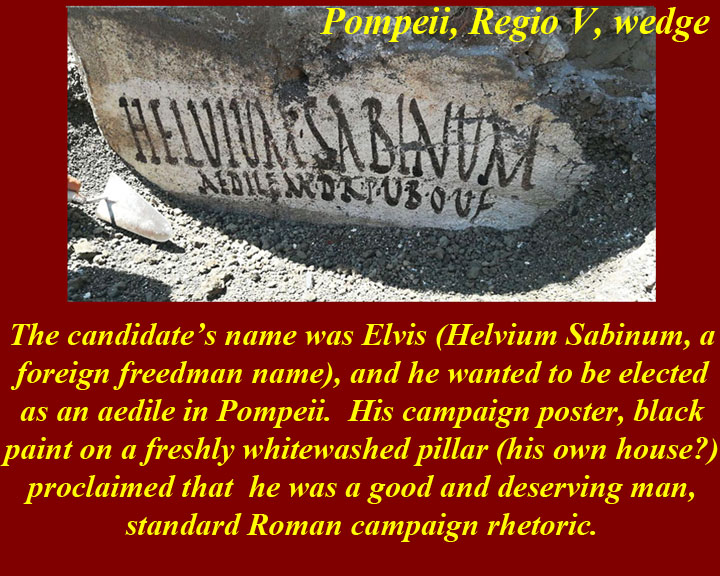
http://www.mmdtkw.org/ALRIVes0300dCandidateElvis.jpg
The fact that this candidates campaign advertisement, found in
the newly excavated "wedge", was newly painted (as were numerous
other such throughout the city) indicates that the autumn
campaign season was under way -- more evidence to support the
October date for the 79 AD eruption of Vesuvius
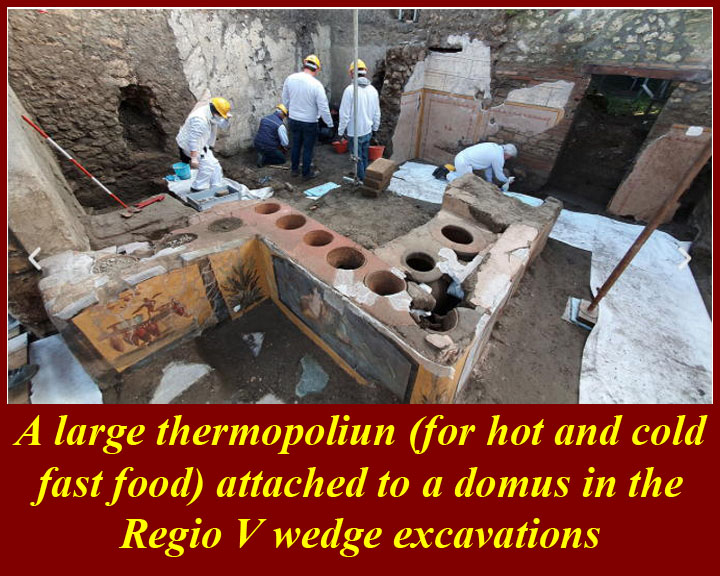
http://www.mmdtkw.org/ALRIVes0300eThermopoliumExcavation.jpg
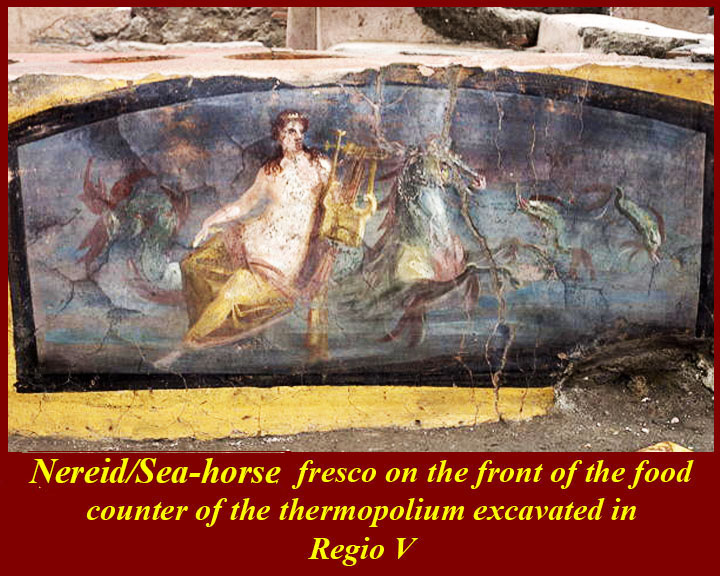
http://www.mmdtkw.org/ALRIVes0300fKitharoidosFresco.jpg
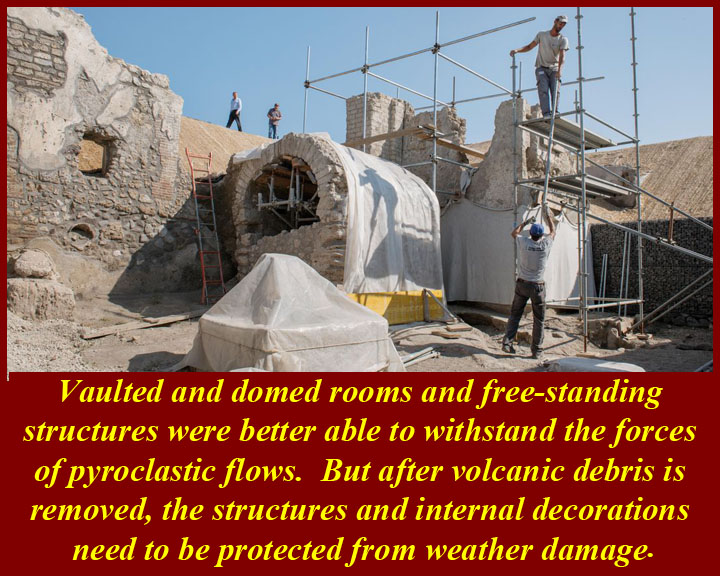
http://www.mmdtkw.org/ALRIVes0300gaVaultedRoom.jpg
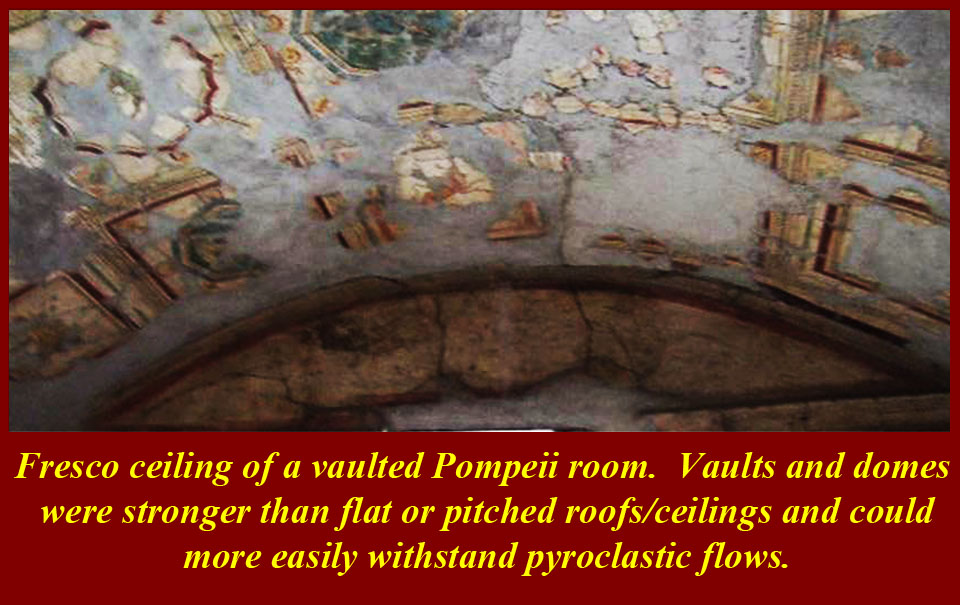
http://www.mmdtkw.org/ALRIVes0300gbVaulted
Ceiling.jpg
This is not the interior decoration of the vault ceiling in the
previous image. It's from another vaulted room in Pompeii,
and it is included here to illustrate that vaulted ceiling
decorations did survive, to some extent, in the city.
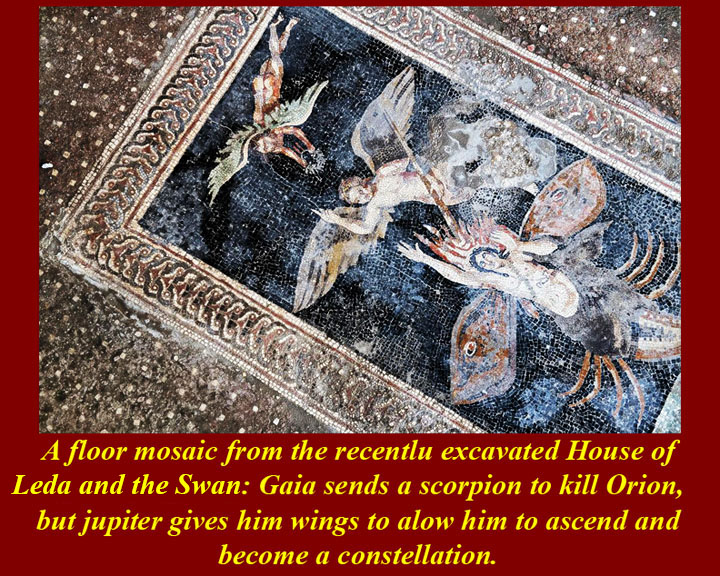
http://www.mmdtkw.org/ALRIVes0300hOrionMosaic.jpg
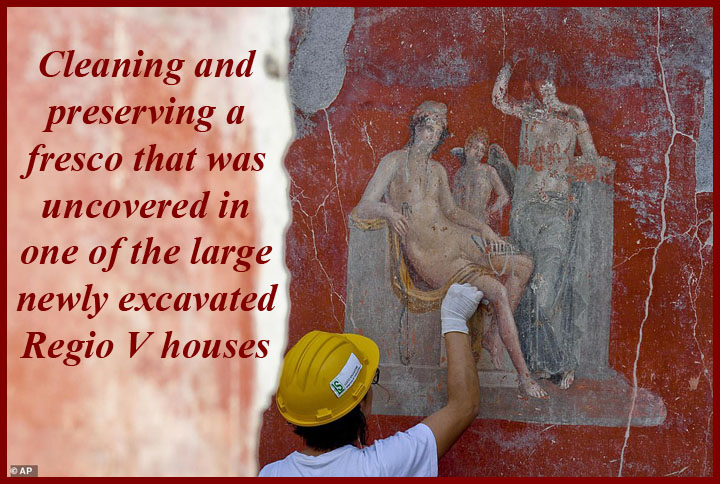
http://www.mmdtkw.org/ALRIVes0300iCleaningNewFresco.jpg
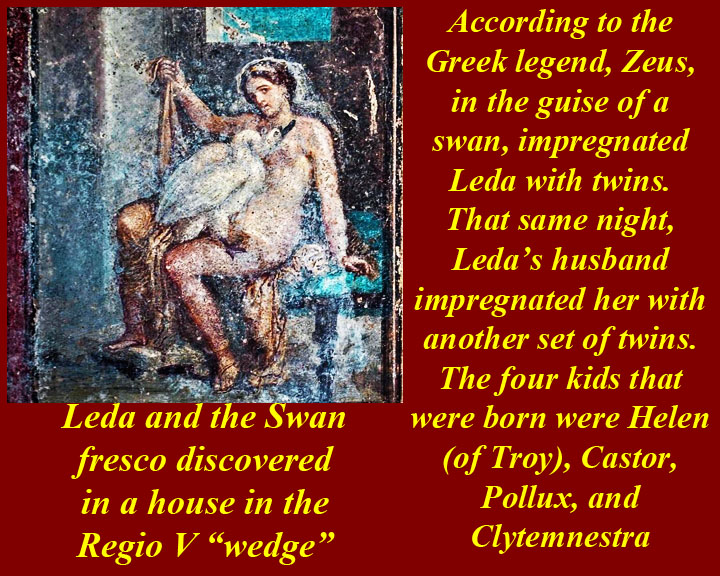
http://www.mmdtkw.org/ALRIVes0300jLedaSwan.jpg
The unvieling of this erotic fresco to the press by former
Pompeii Director Massimo Osanna was part of the media blitz
designed to attract tourism back to Pompeii. Covid 19 lock
downs have , for the moment (April 2021), thwarted the effort.
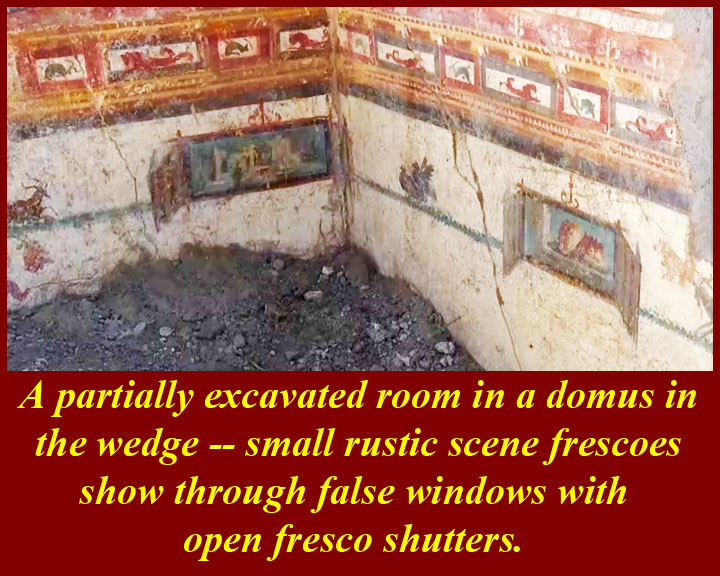
http://www.mmdtkw.org/ALRIVes0300kFalseWindows.jpg
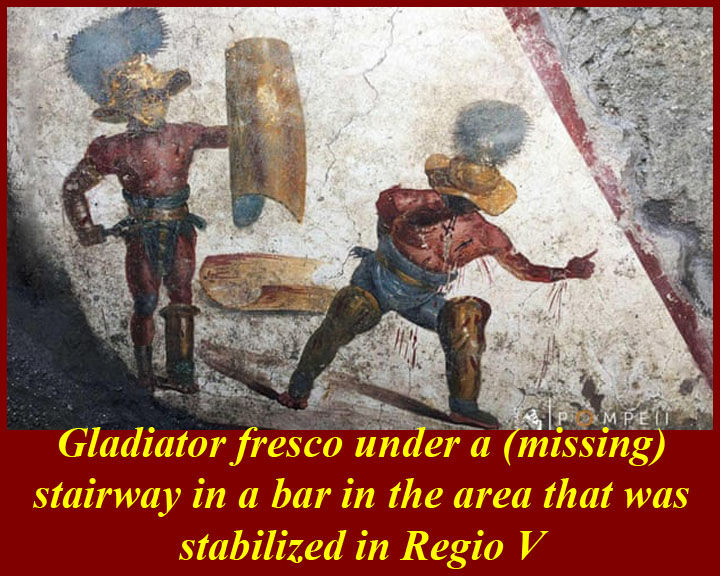
http://www.mmdtkw.org/ALRIVes0300lGladiatorFresco.jpg
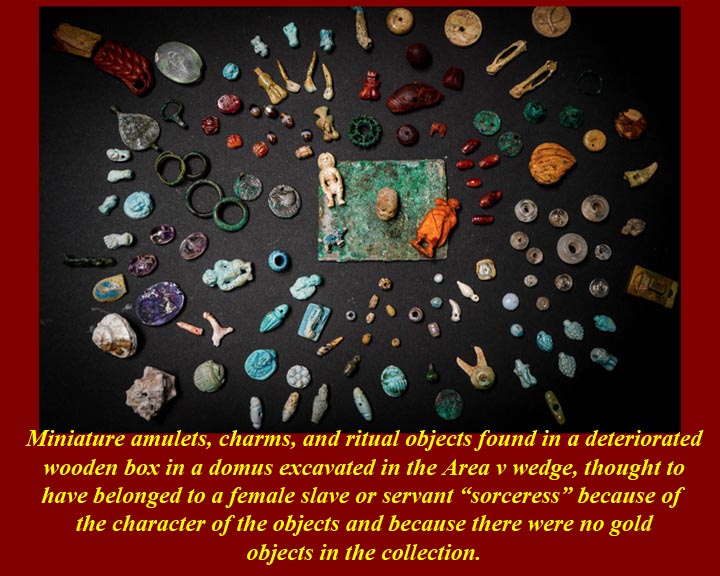
http://www.mmdtkw.org/ALRIVes0300lxSorceressKit.jpg
Everything a resident or itinerant sorceress might need to suit
the dominus, domina, or familia
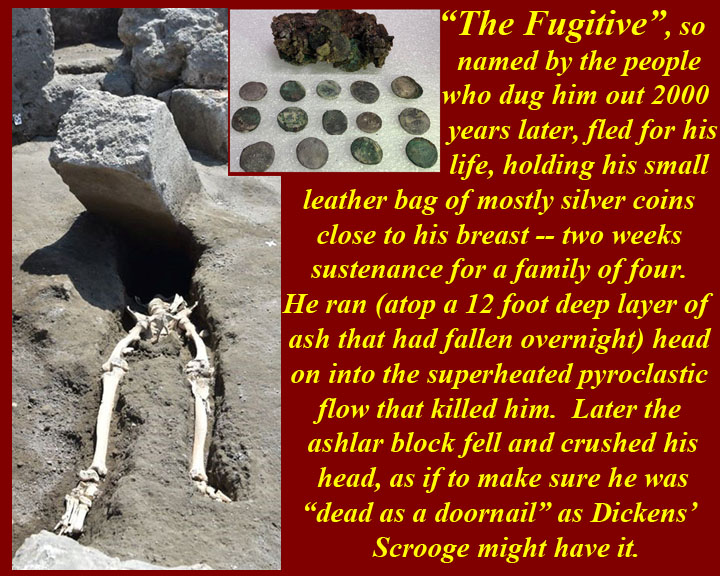
http://www.mmdtkw.org/ALRIVes0300mDoornailDead.jpg
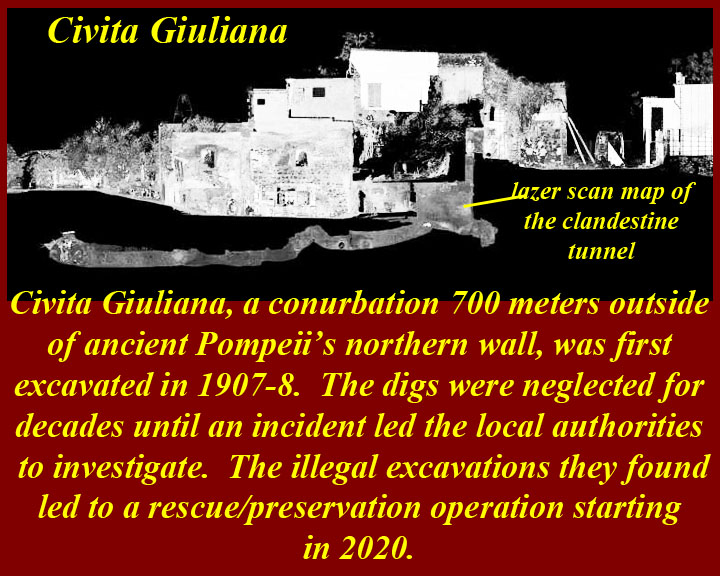
http://www.mmdtkw.org/ALRIVes0300nClandestineTunnel.jpg
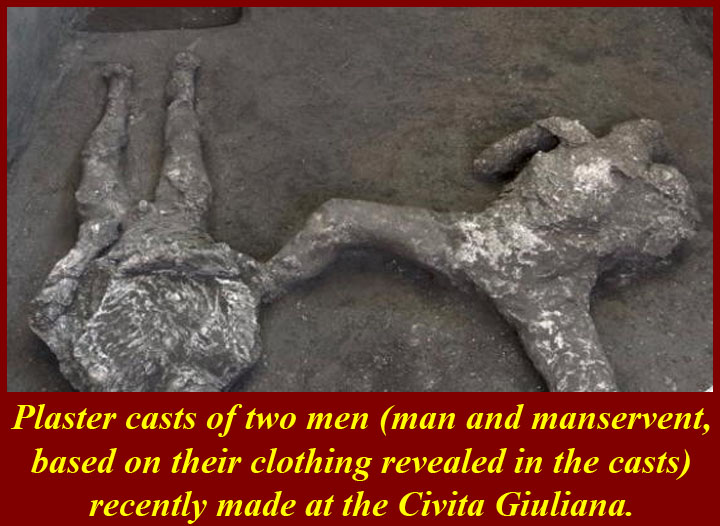
http://www.mmdtkw.org/ALRIVes0300oDeadGuysCivGiuliana.jpg
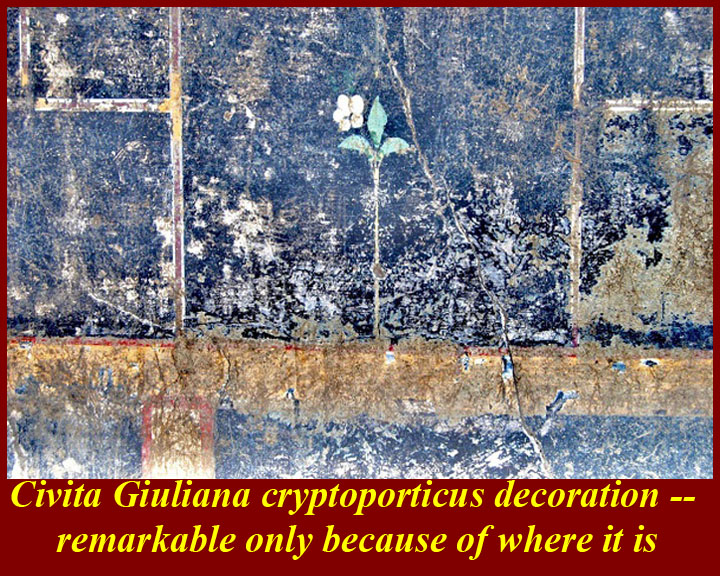
http://www.mmdtkw.org/ALRIVes0300pCryptoporticusDeco.jpg
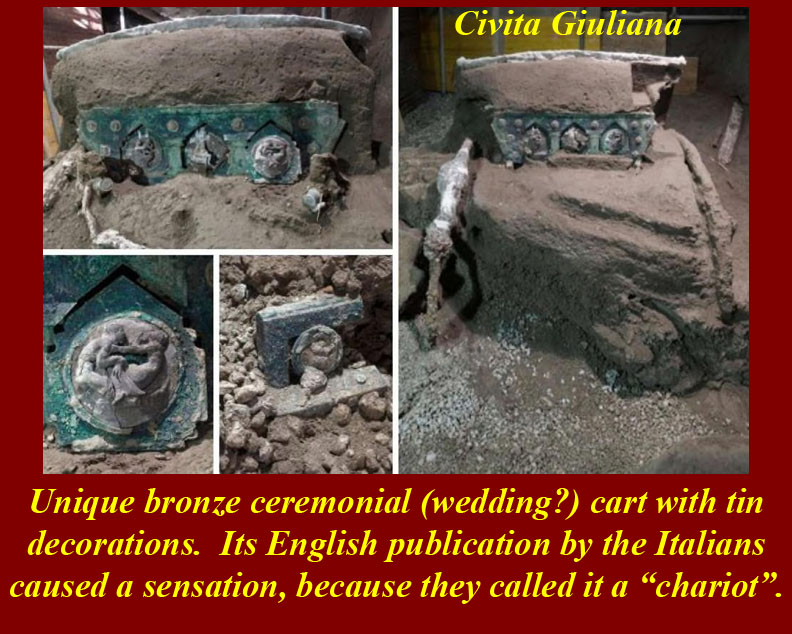
http://www.mmdtkw.org/ALRIVes0300qCeremonialCarriage.jpg
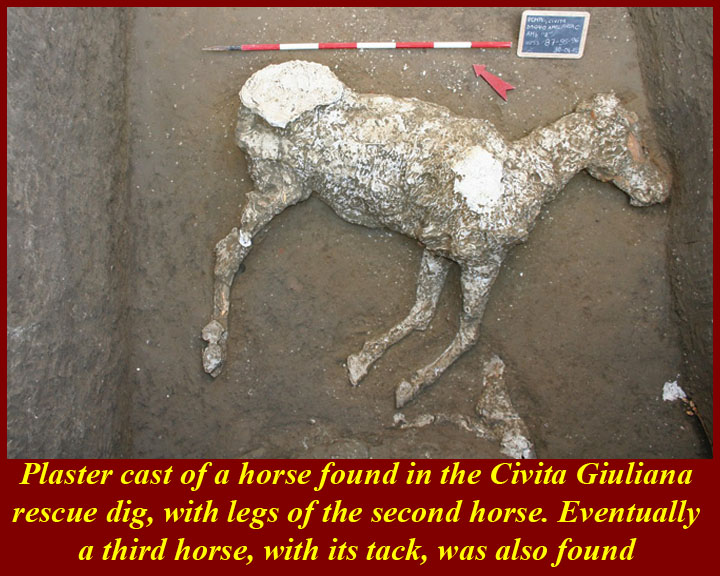
http://www.mmdtkw.org/ALRIVes0300raCavallo.jpg
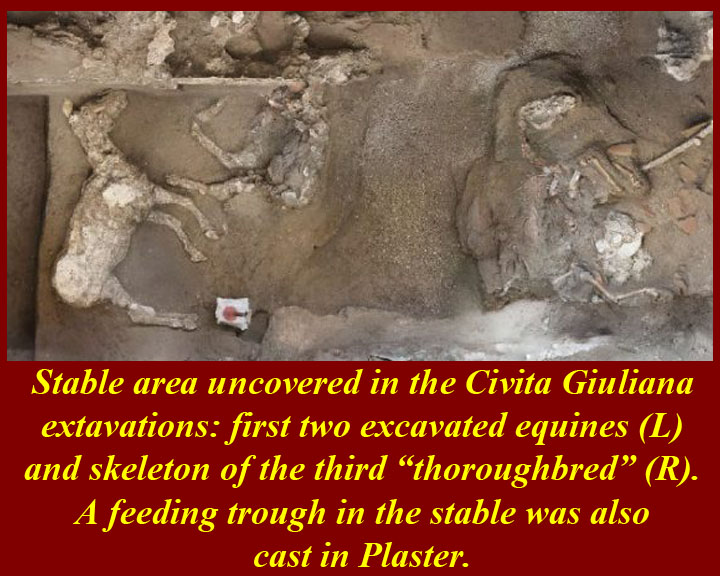
http://www.mmdtkw.org/ALRIVes0300rCivGiulianaStable.jpg
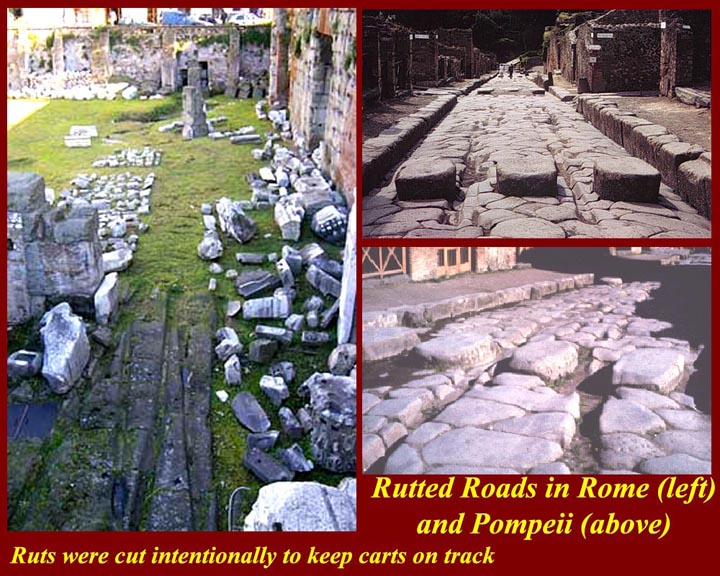
http://www.mmdtkw.org/ALRIVes0302Ruts1.jpg
Guides and guidebooks, not to mention web sites, will tell
you that the ruts in the streets of Roman cities and in Roman
roads were the result of constant traffic of war chariots.
That's all utter nonsense: there may have been some wear
and tear from the wheels of ox carts, but those ruts were cut
purposely to keep heavy wagons on track. Articulated front
axles for wagons weren't invented until the late Medieval
period, so steering was extremely difficult. Tracks were
cut in city streets to help wagons avoid obstacles and to help
them make turns. In some places forked tracks were used
like railroad switches -- a strategically placed stone or wedge
forced the wheels into the correct set of tracks. War
chariots, in fact, were never allowed inside the pomeria (sacred
boundaries) of the cities. Despite the deadly speed and
power of chariot armies there is little record of their use
after ca. 1200 B.C. In fact by the time Rome was founded,
chariots were almost entirely relegated to a ceremonial use and
had no value on the battle field.
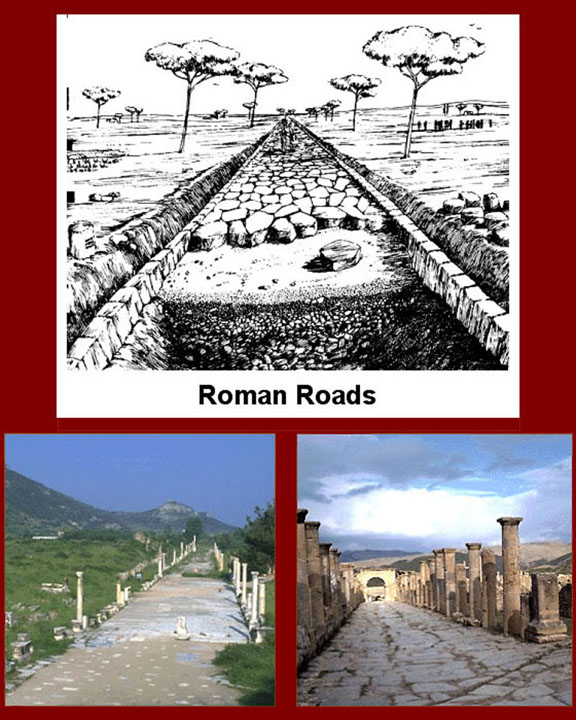
http://www.mmdtkw.org/ALRIVes0303Ruts2.jpg
Roads outside the cities were often high-crowned (i.e.,
humped up in the middle to encourage drainage) so wagons tended
to slide toward the edges. This was especially a problem
when wagons had to move toward the sides in two way
traffic. Ruts cut into the roads would catch the inside
wheel and prevent the curb-side wheel from rubbing or breaking
against the curb. War chariots also never were used
on Roman roads. Even ceremonial chariots were too valuable to be
rattled apart on stone roads. As with tracked
vehicles today, heavy chariots were invariably put on
wagons (often disassembled) when Romans wanted to transport
them. Light wickerwork racing chariots were only used at
racetracks, and even if they did ocasionally appear on roads,
they were to light to cause any damage.
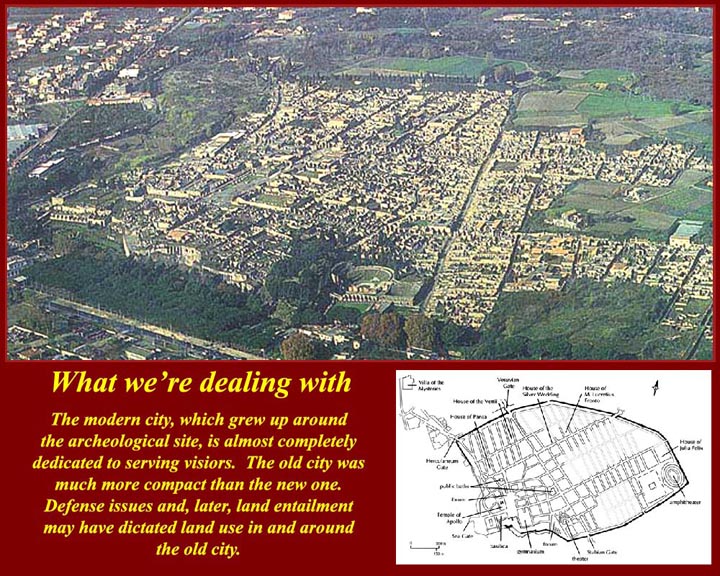
http://www.mmdtkw.org/ALRIVes0304pompei_aerea.jpg
The image clearly shows the (2/3) part of urban Pompeii
that has been excavated over the last few centuries. To
the right of the picture, the two large un-excavated areas of
the city appear as two green area. There may have been
suburban areas outside the walls that have not been
excavated. Modern Pompeii, which provides services to
diggers and tourists, is to the left. Pompeii had "city" status
under Roman law, but it would be a small town by modern Western
standards. Maiuri's estimate of a population of 20
thousand is now widely disputed -- 10 thousand or less is now
more generally accepted. Nonetheless, it is a huge
site by archeological standards with dozens of city blocks (here
called insulae)
of public, religious, and private buildings. There were
business streets, like strip malls, with shops occupying
street-level rooms on the front of large houses, many of which
had upper stories. The city existed for several centuries,
and, during that time, a hodge-podge of structures grew around
each other, with rich and poor living together in
undifferentiated neighborhoods. Some buildings, inevitably
had different functions over time, and some of the largest
houses had subsidiary apartments within their walls at the time
of the eruption. There is no way to know whether shops,
apartments, or light industries were run by the main owner of
the house or whether they rented out space for extra
income. There is also no way to know if upper-class folks
were displaced by a rising middle-class (as Maiuri said) after
the earthquakes of the early 60s AD. Only a small part of
the population was found buried beneath the rubble of the
excavated areas -- many obviosly fled the city in the early
hours of the 79 AD eruption. Depending on how far they
fled and the direction the went, some may have survived, but
many probably were killed in the course of fleeing. They,
of course, are still out in the countryside. With the
benefit of hindsight, they should have headed northeast and gone
more than ten miles to be safe. (As with tornadoes, it's
best to flee at right angles to the path of the approaching
disaster.)
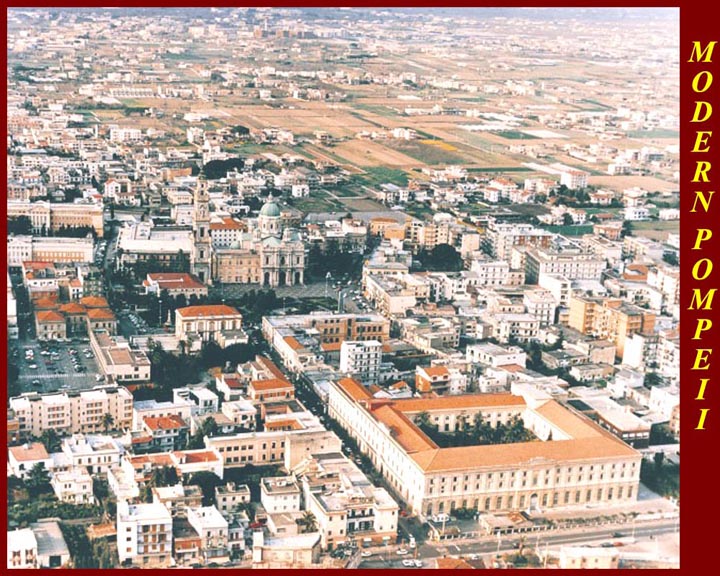
http://www.mmdtkw.org/ALRIVes0305ModernPompei.jpg
Modern Pompeii, like many small Italian towns, centers on
a cathedral. Across the square are government buildings
and a commercial area. Ancient Roman towns were laid out
the same way, but ancient Pompeii was distinctly off
center. This was largely because its growth pattern was
severely restricted by terrain -- it was built on a tongue of
lava from a much earlier eruption and initially built by non=
Romans. After the Roman conquest of the town (General
Sulla took it in 89 BC, Social War) it was greatly expanded
following, as much as possible, a standard Roman grid-like plan.
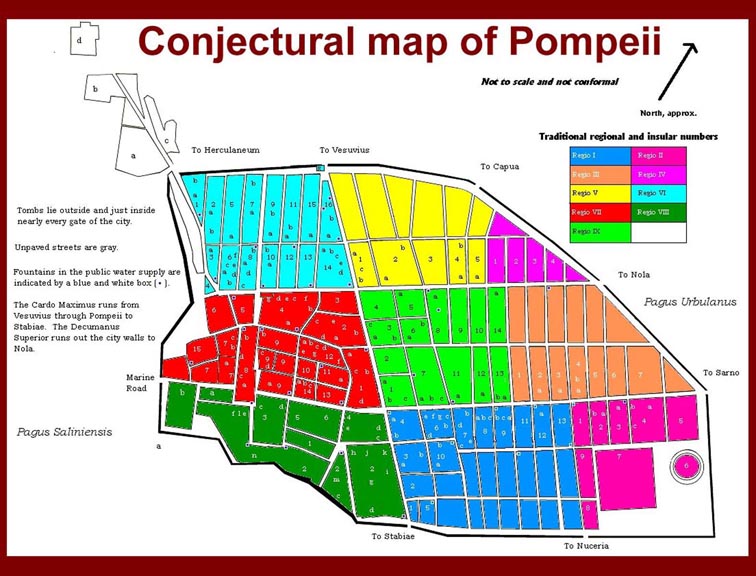
http://www.mmdtkw.org/ALRIVes0306PompeiiMap.jpg
"Regions" and "blocks" (and also "houses") in Pompeii are
artificial divisions made by archeologists (Mostly by August
Mau) rather than neighborhood divisions from ancient
times. The ancient town was probably not large enough to
have administrative subdivisions like the "regiones" of ancient
Rome. The archeological subdivisions were designed to be
used for cataloging finds, but, unfortunately, very much of what
was dug up was unrecorded and simply discarded by archeologists
under pressure to produce prestigious finds.
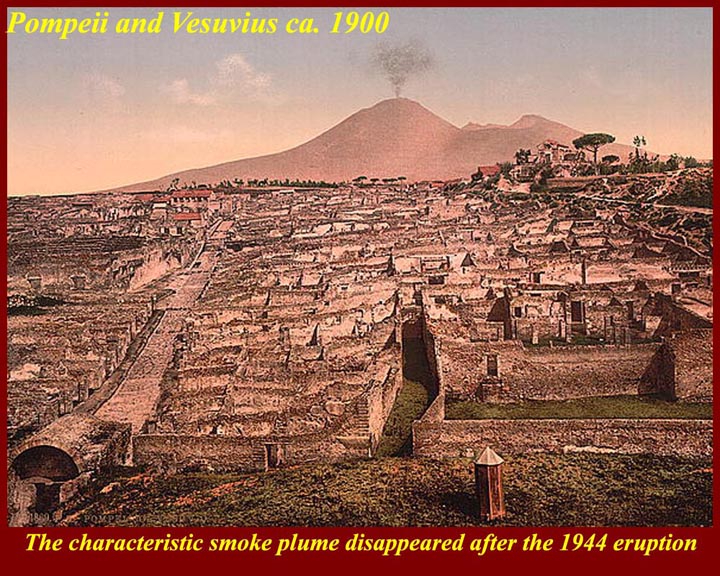
http://www.mmdtkw.org/ALRIVes0307PompeiiVesuv1900.jpg
The big Pompeii dig looked pretty much the same one
hundred years ago as it does today. The volcano, in those
days, was a heavy smoker, but the characteristic smoke plume did
not return after the 1944 effusive (lava) eruption.
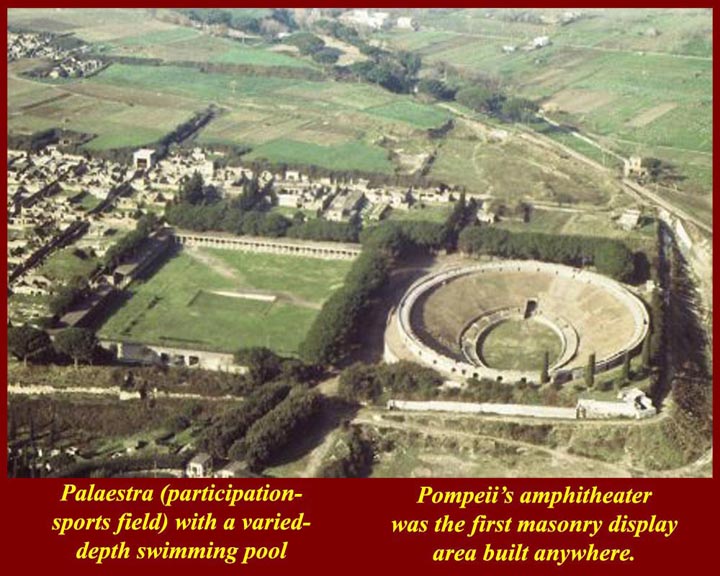
http://www.mmdtkw.org/ALRIVes0308AerialPalaestraAmphithe.jpg
Pompeii's amphitheater, dating from 60 BC is the
earliest known permanent stone ampitheatre
structure: there had been temporary wooden
ones in Rome and elsewhere. This has led some
analysts to speculate that the concept originally
may have been Oscan, i.e., that it was invented by
the pre-Roman population of the region around
Pompeii. Holding only 20,000 spectators, it
was much smaller than the later big one in Rome
(100,000+) and even smaller than many later
provincial amphitheaters. The word
amphitheater means "theater on both sides", that is,
two theaters facing each other. Gladiatorial
and other games among teams from Pompeii and
surrounding towns were held in the arena. The
Palaestra next to the Amphitheater was both a
training ground for athletes and an exercise/game
field for the citizenry. In the center of the
Palaestra was a swimming pool, deeper on one end
than the other much like modern pools. Many
Italian towns still today have one or more
palaestrae. An incomplete but still extensive list
of Roman ampitheatres is at
http://en.wikipedia.org/wiki/List_of_Roman_amphitheatres.
Next to the palaestra (above it in the image) was
a large
complex of properties belonging to Giulia Felice
("Lucky Julia"), built toard the end of the 1st
century BC, incorporating several previous buildings
into a single complex that can only be described as
an urban resort characterised by the predominance of
green areas, outdoor triclinia, lounges, and by some
accounts, rental suites where sexual activities
could be arranged. The property is set into four
different cores with separate entrances: an atrium
house, a large garden which opens on a number of
residential areas, a thermal facility and a large
park.
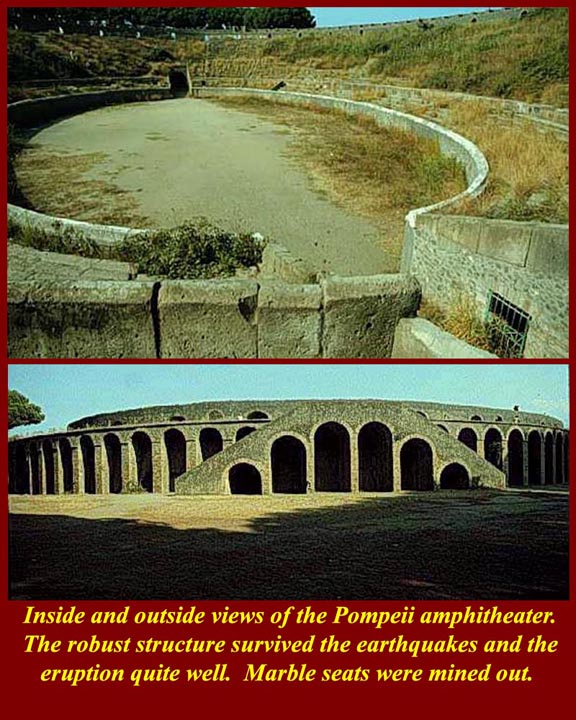
http://www.mmdtkw.org/ALRIVes0309AmphitheatreInt.jpg
Inside and outside the Pompeii amphitheater, which,
because of its concrete core, survived the pyroclastic surges
and flow. It was completely buried and in very good
condition until marble miners took most of the seating for use
in Renaissance and later buildings.
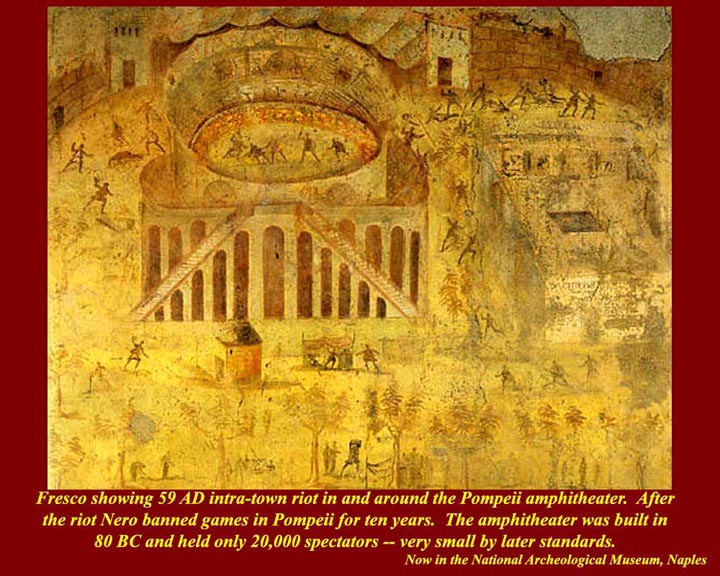
http://www.mmdtkw.org/ALRIVes0310Amphpainting.jpg
The slightly electronically enhanced image shows a
painting from Pompeii of a riot in and around the Pompeii
amphitheater in 59 AD. The genesis of the riot is obscure,
but it is recorded that several visiting fans from neighboring
Nucera were killed. Nucera was a rival of Pompeii in more
than sports, so the riot may not have been only sports
related. Nero banned games for ten years in Pompeii after
the disturbance. The painting clearly shows a retractable
awning to shade spectators.
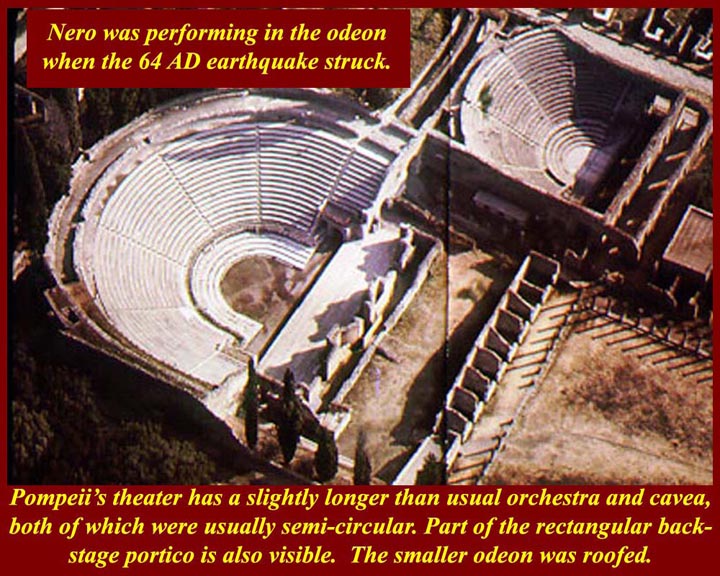
http://www.mmdtkw.org/ALRIVes0311AerialTheaterOdeon.jpg
Large theater and odeon. The smaller odeon was
roofed over and the theater, according to painted advertisements
in the city, could be covered by retractable awnings. Also
visible in the picture is one end of the rectangular area behind
the stage of the theater and a similar area behind the odeon
where food and refreshments and necessary conveniences were
available. Theater and odeon performances most often had
semi-religious and quasi-patriotic festival aspects and
performances of several different plays/odes would follow each
other on the same day: spectators might arrive at dawn and stay
until sunset, so the backstage rest areas were much
needed. It is recorded that Nero was performing one of his
original odes in the Pompeii odeon when the 64 AD earthquake
struck and that he remarked that his survival and that of the
audience was a sign that the gods were pleased with his
performance. Odes were usually performed in a dily lot
venue, self accompanied on the Greek Lyre, the musical
instrument associated with Apollo.
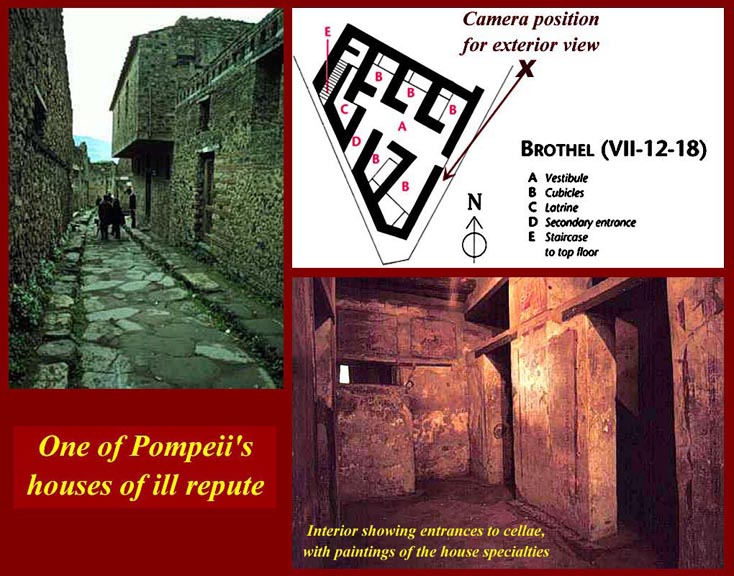
http://www.mmdtkw.org/ALRIVes0312Brothel.jpg
After a hard day of watching plays in the theater or
playing trigon in the palaestra, Marcus Pompeiannus might head
for this address for a little extramarital activity. Sex
was recreational and omnipresent in Pompeii and elsewhere in the
ancient Roman world. Roman male citizens were expected to
have extramarital encounters -- they weren't exactly condoned,
but they also went pretty much unpunished. Women might
also get a little on the side, but they were expected to be
discreet: bringing dishonor to the name could earn a woman
disgrace, exile, or even death. Pompeii was particularly
notorious even in the ancient Roman context.
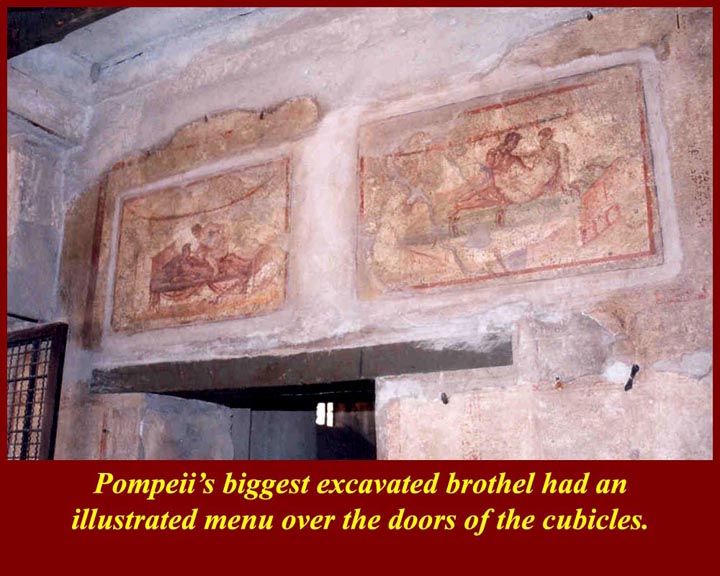
http://www.mmdtkw.org/ALRIVes0313PompeiiBrothel.jpg
Above the doorways of the cubicles (six on the first floor
and more on the second) were pictures showing different kinds of
available entertainment.
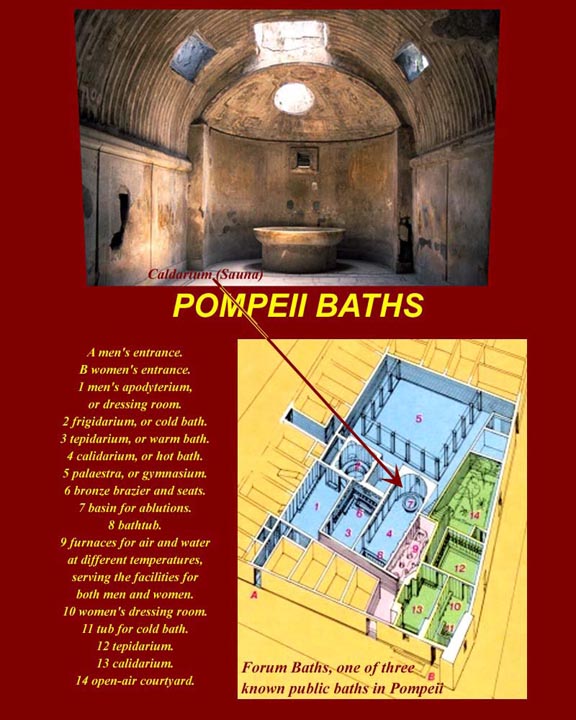
http://www.mmdtkw.org/ALRIVes0314PompeiiBaths.jpg
The "Forum Baths": Pompeii had at least three sets
of public baths: there may be more still to be
excavated. They were, of course, smaller than those in
Rome, but they still followed the basic pattern with "hot rooms"
(calidaria), "warm rooms" (tepidaria), and "cool rooms"
(frigidaria). Public baths also included unroofed swimming
pools and small participation sports fields. Officially,
men and women bathed separately, but for a fee, the whole bath
could be had for private after-hours co-ed parties. (Later
in the empire, co-ed bathing became more common, but Pompeii had
already been buried by then.) Baths like those of ancient
Rome are still available in Albania, Turkey, and the Middle East
-- and the private party option still exists. There are,
of course still operating "spas" in Europe and elsewhere in the
west. Some of the baths are actually restored or remodeled
ancient Roman baths -- including the eponymous one at Spa in
England. The highly sulfurous Roman bath at Bagno Tivoli,
forty-five minutes west of Rome, a favorite resort of Hadrian,
is still open for business -- and you can smell it from miles
away.
Parts of the forum baths now house the only bar, restaurant, amd
ice cream stand in the ruins of Pompeii.
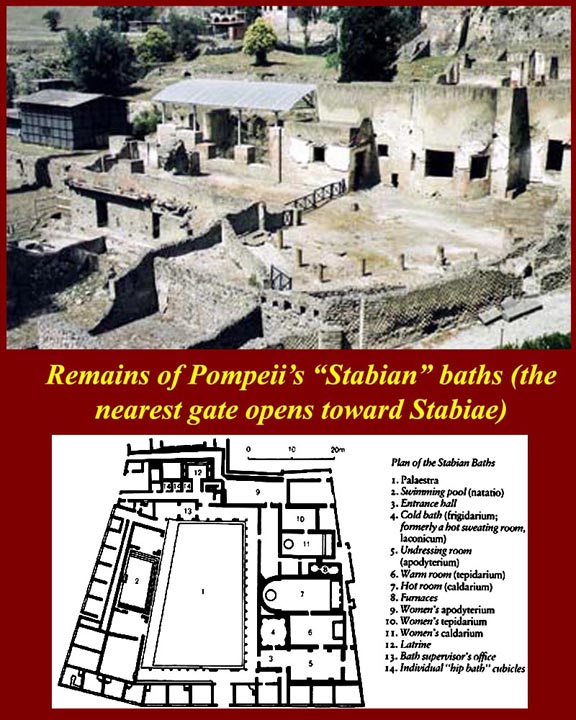
http://www.mmdtkw.org/ALRIVes0315PompeiiStabiaBaths.jpg
The Stabian baths were near the gate of Pompeii through
which ran the road to Stabiae, down the coast. The
compound had a relatively larger palaestra and lots of small
private rooms. Some analysts have decided that these baths
also hosted a corps of prostitutes.
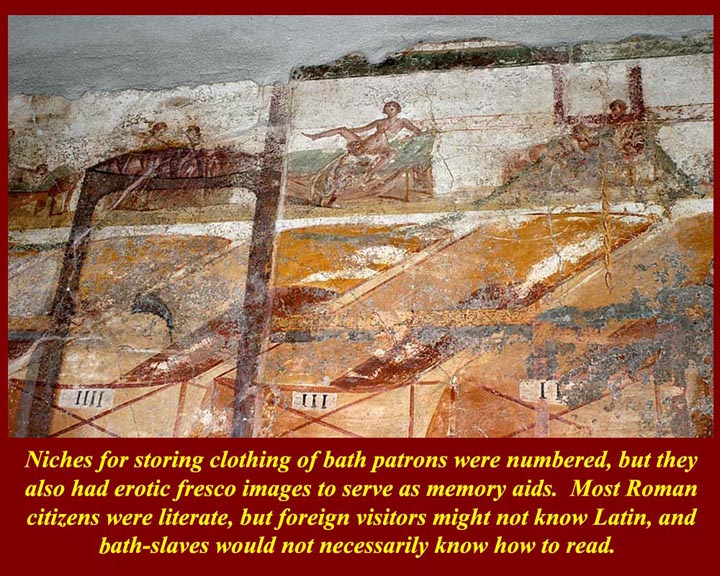
http://www.mmdtkw.org/ALRIVes0316BathErotica1.jpg
Baths had apodyteria or changing rooms with cubby-holes
for the clothing of patrons. Actual bathing was a buck
naked operation. A slave might be set to guard the
patron's clothing. Theft must have occurred, because
curses against thieves survive as graffiti, and there are
references to patrons going home naked in theatrical
comedies (in fact, highly unlikely -- the baths would have
provided at least rudimentary garb for a quick trip home.)
The Forum Baths of Pompeii had erotic illustrations above each
of the cubbies, perhaps to serve as for patrons who may
have relaxed too much and too long in the baths or perhaps to
help an illiterate slave on errand to find a master's clothing
-- "Go get my toga from below the cunnilingus!".
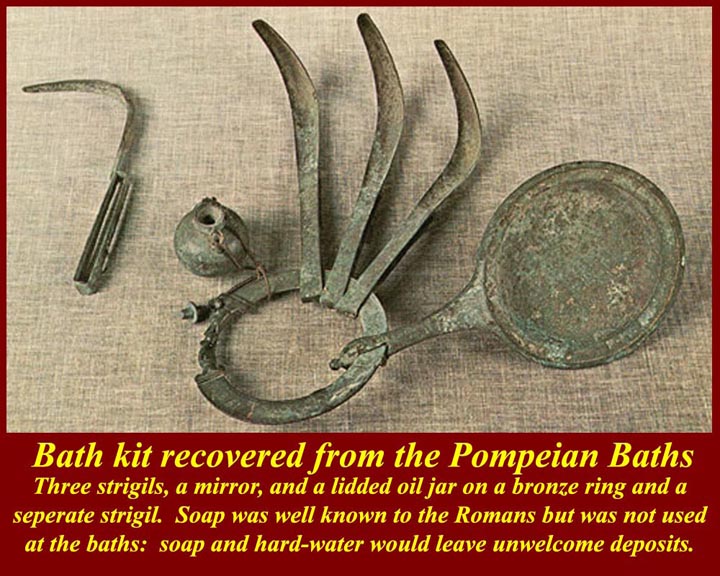
http://www.mmdtkw.org/ALRIVes0317BathTools.jpg
Bath tools were private property, but these were left
behind in the rush to escape the volcano. The curved tools
are strigils of scrapers -- the root of the word is the same as
for the English word astringent. After exertion in the
palaestra, olive oil (perhaps scented) and a mixture of fine
volcanic sand and ash would be rubbed on the skin and then
scraped off with a curved strigil. The set shown here has
the stoppered oil bottle and also a mirror attached. The
oil and ash would almost make a liquid soap and the sand would
serve as a mild exfoliant -- the same ingredients, boiled down
and cut into bars would give you Lava(tm.) soap. It was
considered really declasse to jump in the pool without first
applying the strigil -- something a barbarian visitor might
do. Visitors to Roman towns were steered directly to the
nearest baths to wash off the journey's dust. There was a
minimal fee for use of the baths, usually the smallest coin,
but, also usually, local politicians or magistrates would put
baskets of coins at the entrance to the baths and often with an
accompanying political campaign slogan: although the
emperors might arrogate their office, local elections were real,
and, judging from graffiti and professionally painted signs, a
political campaign had just finished at the time of the 79 AD
eruption. This should have been a clue that the
eruption took place in the fall of 79AD rather than in August as
it was thought to have been until a grafitto "date stamp" was
found in the recent new excavations in Area V.
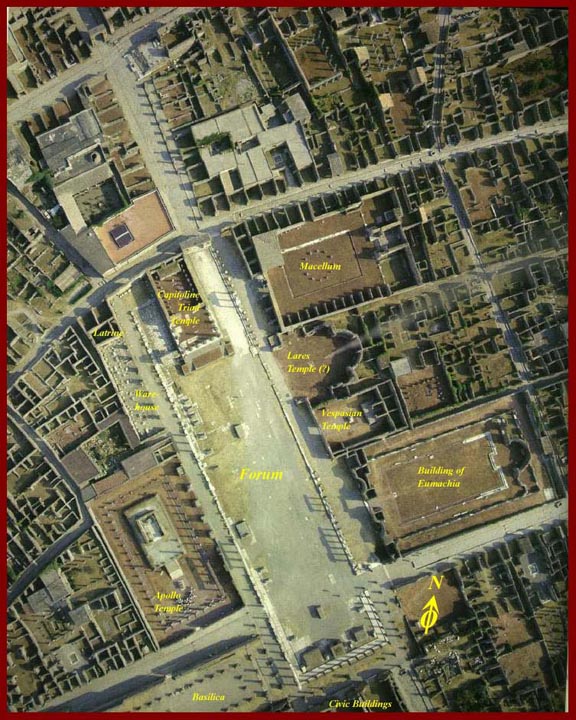
http://www.mmdtkw.org/ALRIVes0318ForumBaloonLabeled.jpg
Photo of the forum shot from a tethered balloon.
Roman municipalities always had a forum where public religious
and civil/civic functions were carried out. Around the
Pompeii forum were ranged the offices of the civic magistrates,
a comitia or
local election and civic announcement venue, several
temples (temples of Apollo/Dianna; of the "Capitoline Triad" --
Jupiter, Juno, Minerva; of the Imperial Cult -- rededicated to
the recently dead and deified Vespasian right before the
eruption; and of the municipal "lares", which were
place-specific patron gods), a civic basilica where civil law
judges and notaries sat, an office of weights and
measures (the mensa
ponderaria, or weight board), a macellum or
open-air market, and the meeting hall of the town's most
important fullers and dyers guild, called the Eumachia Building
because Eumachia, an important local priestess, had built it for
the guild. The Isis temple, because it was foreign, was a
few blocks away: foreign cults were usually banned from
Roman fora (one known exception being the Castor and Pollux
temple in Rome.)
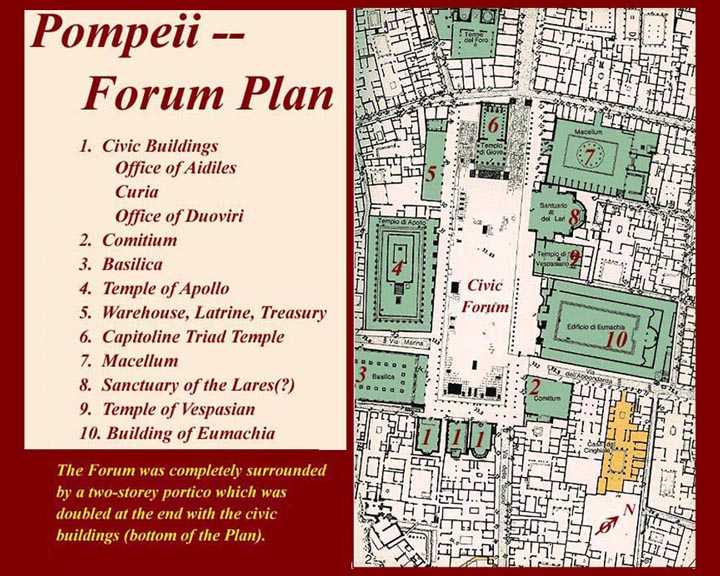
http://www.mmdtkw.org/ALRIVes0319ForumPlan.jpg
Plan of the Pompeii forum
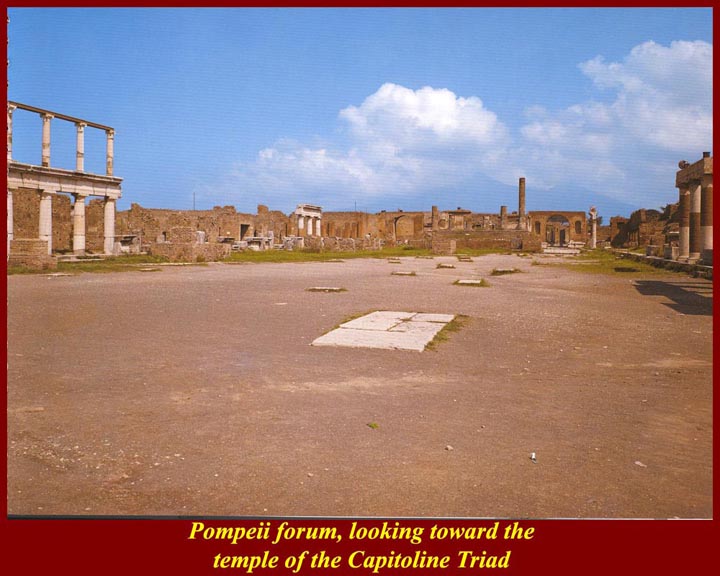
http://www.mmdtkw.org/ALRIVes0320PompeiiForumA.jpg
The Forum in its ruins, view from in front of the comitium
toward the Capitoline Triad temple.
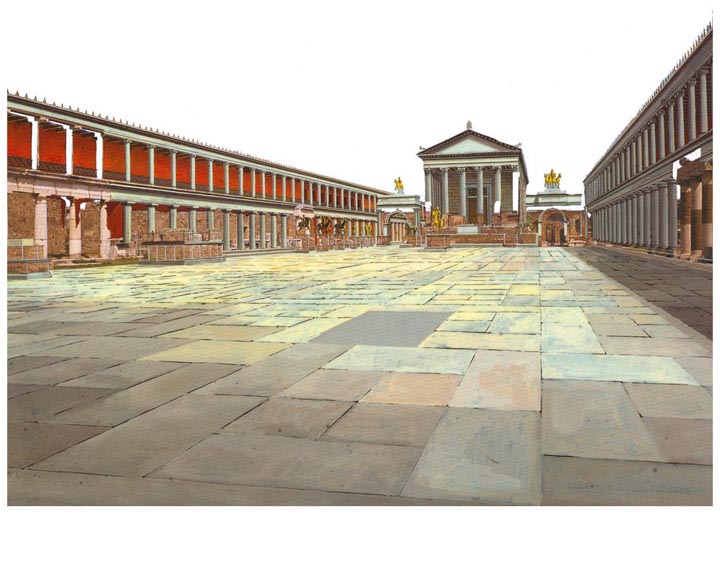
http://www.mmdtkw.org/ALRIVes0321PompeiiForumB.jpg
Overlay for the preceding image -- the same view of the
forum before the eruption (but the big temple of the Capitoline
Triad -- Jupiter/Juno/Minerva -- was only partially
reconstructed on the day.
The following images are of Pompeii forum
buildings:
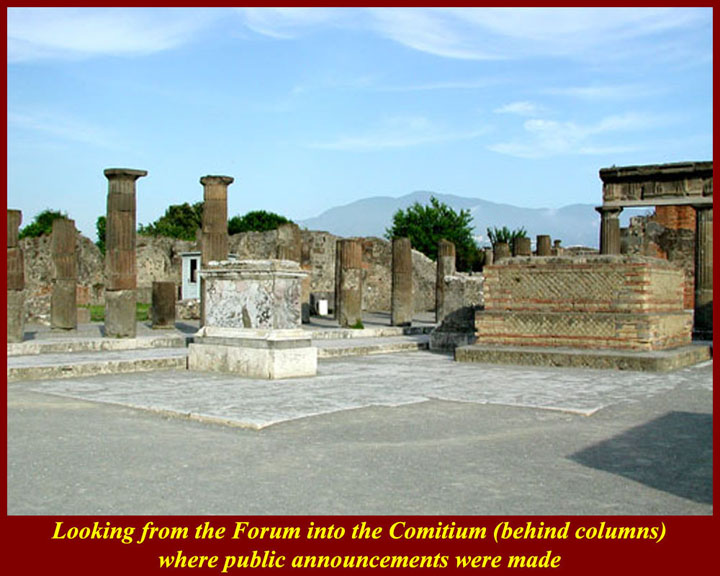
http://www.mmdtkw.org/ALRIVes0322Comitium2.jpg
The comitium -- local elections, civic announcements
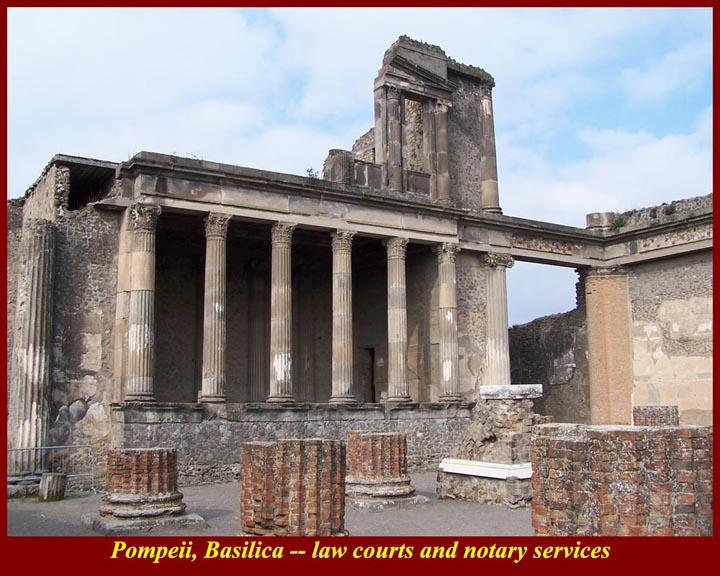
http://www.mmdtkw.org/ALRIVes0323PompeiiBasilica.jpg
Basilica -- civil courts, notaries (also private business
deals). This building is heavily reconstructed;
lighter sections are new masonry.
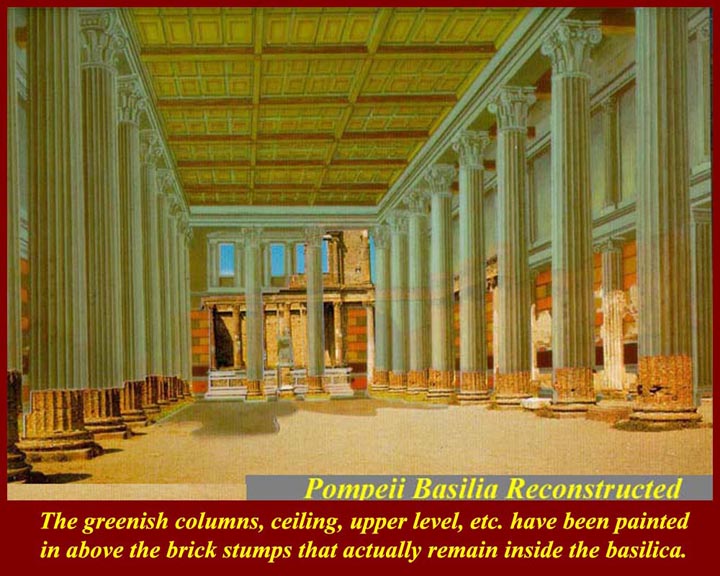
http://www.mmdtkw.org/ALRIVes0324BasilicaReconstructed.jpg
The interior of the Basilica -- artist's rendering
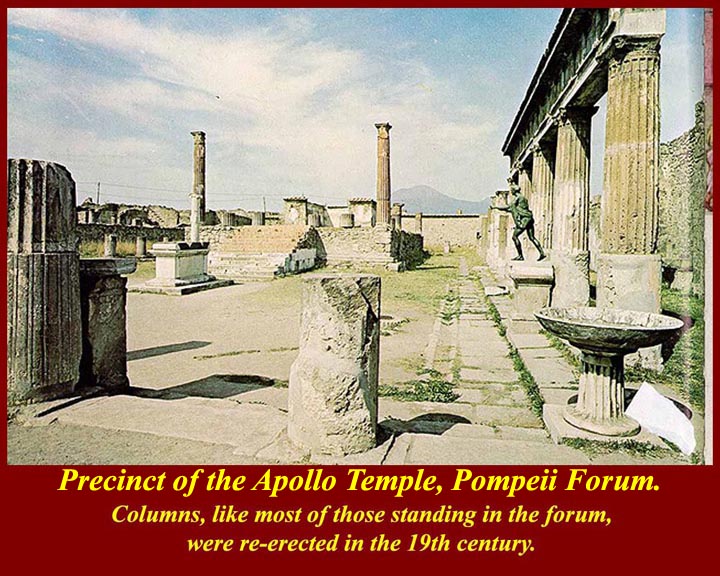
http://www.mmdtkw.org/ALRIVes0325AltarPodiumApollo.jpg
The Apollo Temple precinct was next to, but on a slightly
different axis from, the forum. Is thought to be an
indication that the temple predated the layout of the forum.
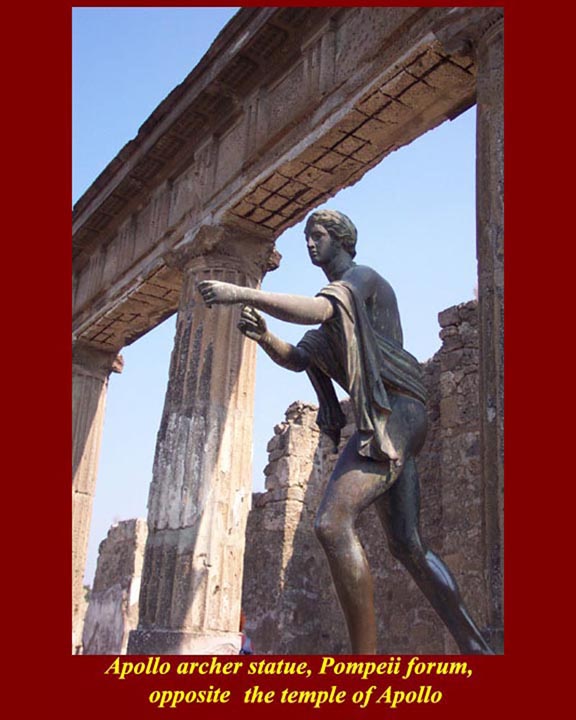
http://www.mmdtkw.org/ALRIVes0326Apollo.jpg
Apollo, the Archer statue -- replica of the statue of
Apollo tin an archery pose. The original, slightly less
than five feet tall, is in the National Archeological Museum in
Naples, having been restored most recently at the Getty Museum
in Malibu, Califirnia (2009).
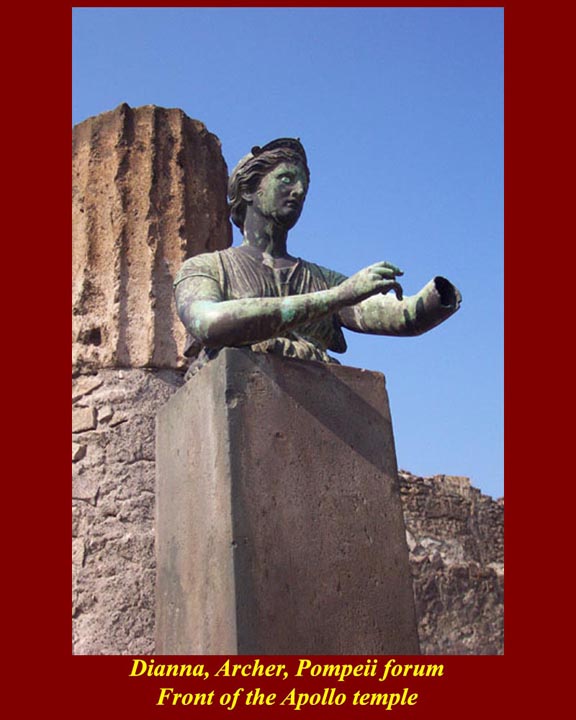
http://www.mmdtkw.org/ALRIVes0327DiannaApolloTemple.jpg
Diana, the Archer -- replica. The original is in the
National Archeological Museum in Naples. her lower half
was not found.
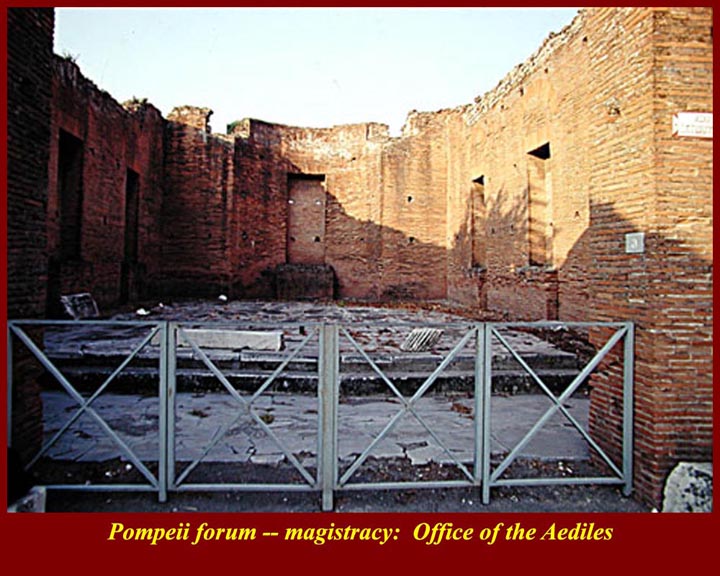
http://www.mmdtkw.org/ALRIVes0328Magistrates.jpg
One of three side-by-side magistracy offices on the
southern end of the forum, opposite the Temple of the Capitoline
Triad. Most Roman forums had "civic" offices on one end
and a "religious" opposite end, although it always got somewhat
confused as more civic and religious buildings sequentially were
built.
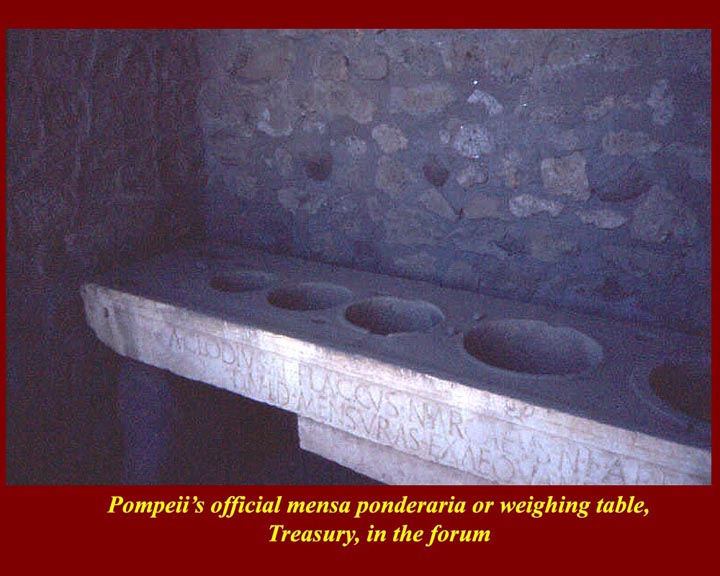
http://www.mmdtkw.org/ALRIVes0329MensaPonderaria.jpg
The mensa
ponderaria. Weights and balances were
found here along with the graduated volume measurement table.
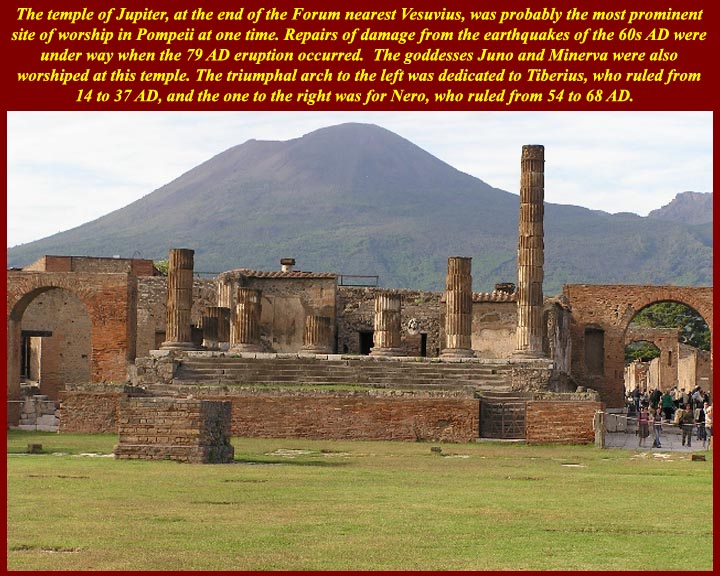
http://www.mmdtkw.org/ALRIVes0330Triad1.jpg
Podium and sacrificial altar of the Capitoline Triad
temple (sometimes simply labeled as the temple of Jupiter.
It had three separate internal mysteria within the cella, one for for
Juno, the central one for Jupiter (= Diu, or Zeus Pater = "God
the Father"), and the third for Minerva. Jupiter was also
known as Jove, Juno was his wife, and Minerva was the "other
woman" -- apparently inherited by the Romans from the
Etruscans. Minerva was sometimes identified with Athena.
The temple was first built by the Oscans who held the town
before the Romans conquered it, and it was probably originally
dedicated to the Oscan equivalent of Jupiter, Diu Vei (which, of
course, is a linguistic cognate of Jove).
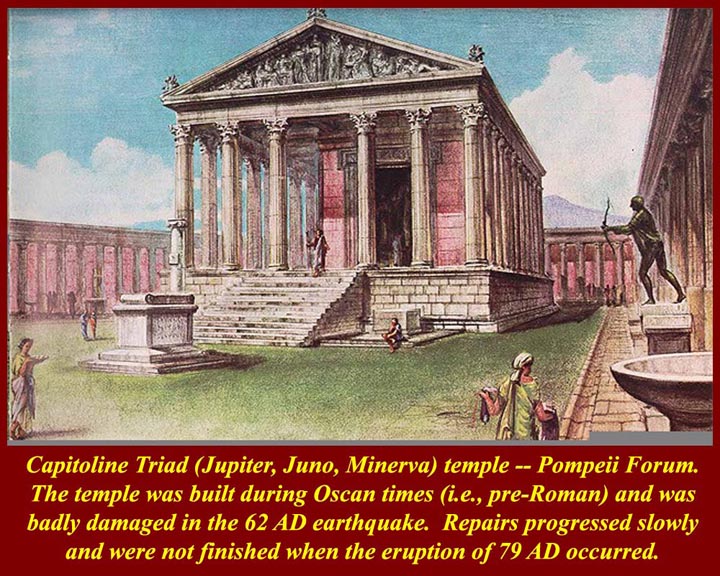
http://www.mmdtkw.org/ALRIVes0331Triad2.jpg
An artist's impression of how the Apollo temple may have
looked before the eruption. The Capitoline Triad temple
would have had the same general external aspect.
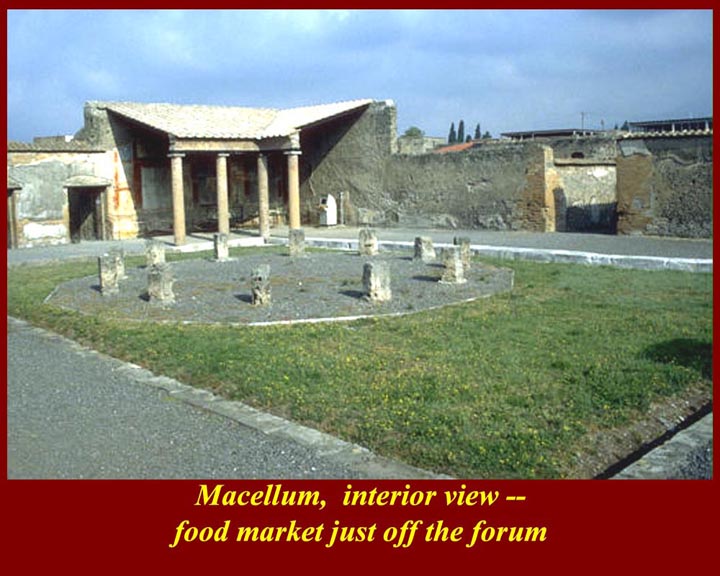
http://www.mmdtkw.org/ALRIVes0332Macellum1.jpg
Pompeii forum macellum: Looking across the inside of
the macellum at a corner of the market that was reconstructed to
cover and preserve wall frescoes. The word macellum really
means "meat market" and was appled to this area by the
excavators (modern Italian macelleria =
"butcher shop), but it's fairly certain that other foods were
also sold here. There were numerous stalls inside and outside
the walls of the market, just as there are in the many
neighborhood markets Mussolini built throughout Italy to replace
local street markets.
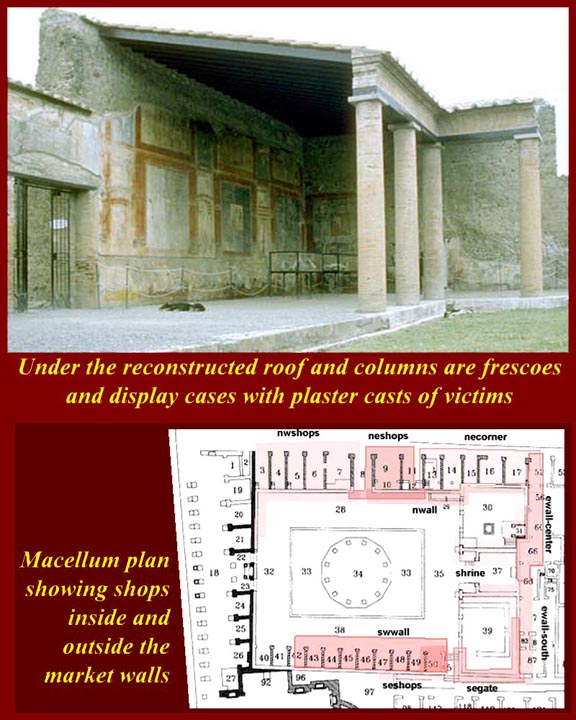
Macellum: a closer view of what's under the
reconstructed roof, and a plan of the macellum
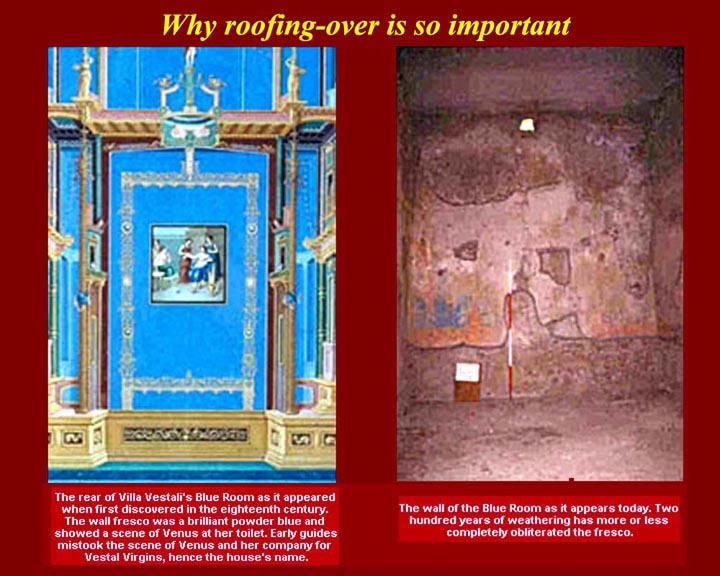
http://www.mmdtkw.org/ALRIVes0334WeatheringLosses.jpg
Not in the macellum, but a good example of why it's
important to keep frescoes safe from the elements -- the Blue
Room in the Villa Vestalis as it appeared shortly after
excavation and 200 years later
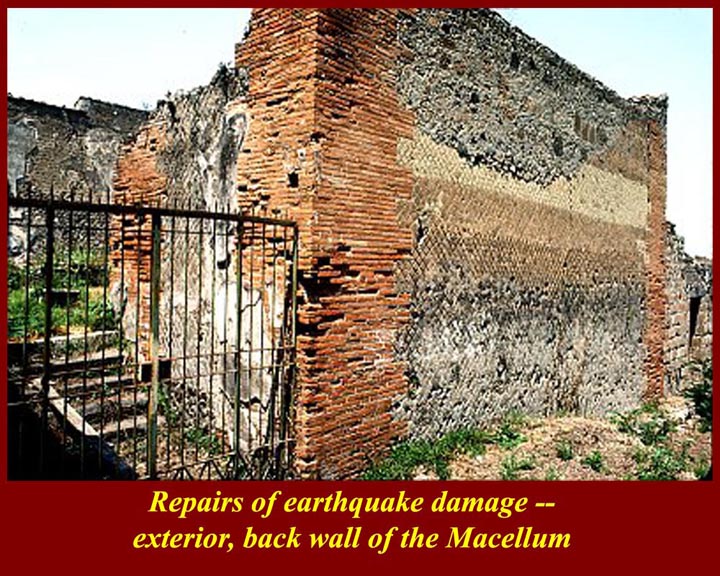
http://www.mmdtkw.org/ALRIVes0335MacellumEarthquake.jpg
The exterior rear wall of the macellum where repairs of
damage form the earthquakes of the early 60s AD are visible.
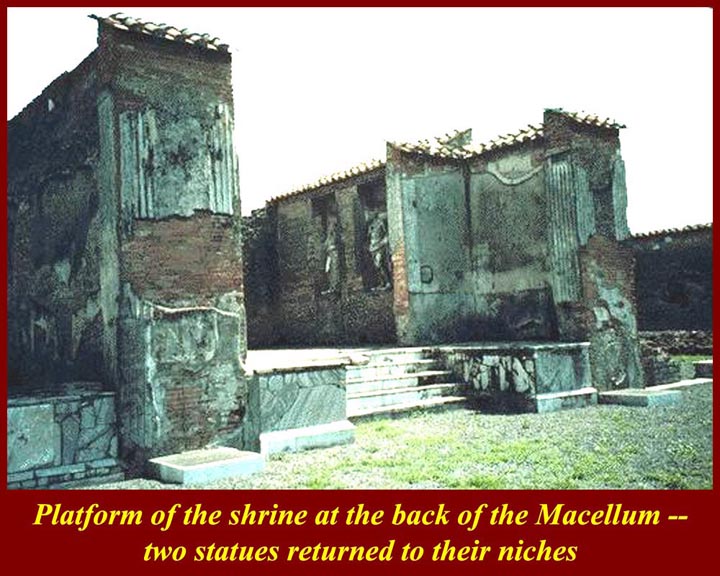
http://www.mmdtkw.org/ALRIVes0336MacellumShrine.jpg
Macellum -- the raised shrine at the back of the
macellum. There were rituals and rites associated with the
sale of foodstuffs and especially with the slaughter of
animals. Similar rites can still be seen early mornings in
the Arab "triple suq" in Jerusalem and in the meat market off
the "Street called Straight" in Damascus. Mediterranean
Christians have pretty much gone to an annual "blessing of the
flocks" but a prayer is often still muttered by the
superstitious butcher even as he (very seldom, she) cuts a steak
or chop.
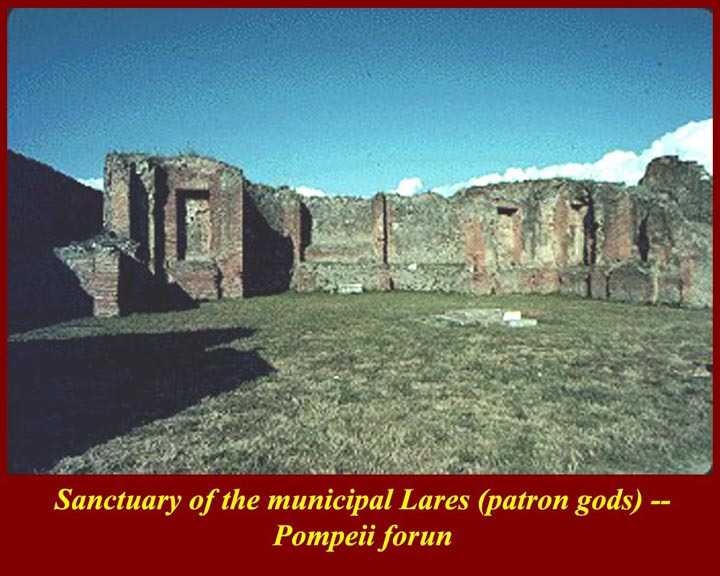
http://www.mmdtkw.org/ALRIVes0337LaresSanctuary.jpg
Municipal Lararium. Every family, every shop, every
guild of fraternity, every neighborhood, every town had its own
"guardian angels" or "household gods", i.e., minor gods called
Lares, who were supposed to deflect misfortune. Of course,
they were sometimes outwitted by the Fates -- it certainly
happened here. The modern Italian equivalent is the
madonnella, a small shrine inside the house (almost always to
the Madonna and hence the generic name) or a streetside shrine
on the side or corner of a building. (An extensive picture
compendium of the madonnelle of modern Rome is on the Internet
at http://www.photoroma.com/madonnelle.php.)
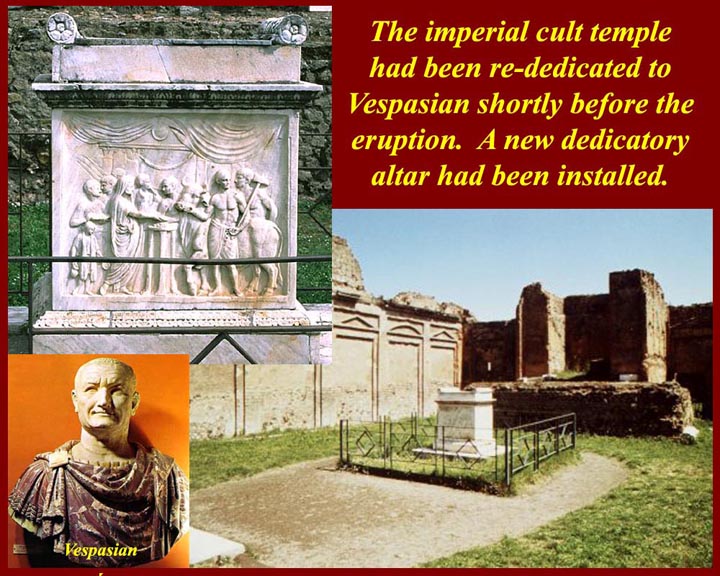
http://www.mmdtkw.org/ALRIVes0338TempleVespasian.jpg
By 79 AD dead Emperors were routinely "deified", so there
was, in every town, a temple for the Imperial Cult. This
was particularly important just at the time of the
Eruption. Vespasian and later Titus had put down a revolt
of the Jews from 67 through 70 AD (Destruction of the Jerusalem
Jewish Temple) over the question of homage (i.e., ceremonial
subservience) to the Roman Imperial cult. In July of 79
AD, a month before the eruption, Titus had rededicated the
Pompeii temple of the Imperial cult to his dead father,
Vespasian. The pristine new dedicatory altar today
stands in front of the ruins of the temple.
(P.S. -- If, like me, you have trouble remembering how to spell
"deified", remember that it's a palindrome -- spells the same
backward and forward.)
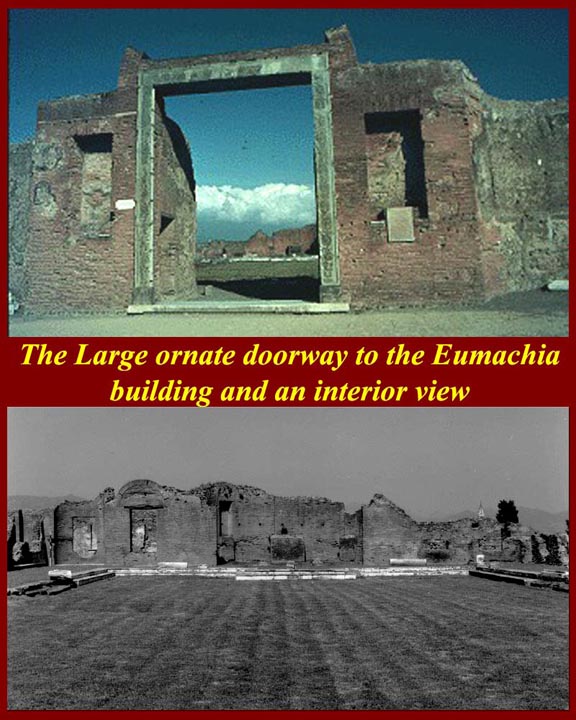
http://www.mmdtkw.org/ALRIVes0339Eumachia1.jpg
Eumachia was a priestess and prominent citizen of Pompeii.
She was patroness of the guild of fullers (cleaners, dyers, and
clothing makers), one of the most influential trade-guilds of
the city because of the importance of the wool industry in
Pompeii's economy. Although her ancestry was humble, the fortune
she inherited from her father, a brick manufacturer, enabled her
to marry into one of Pompeii's older families. She provided the
fullers with a large and beautiful building which was probably
used as the guild's headquarters. Over each of the two
entrances to the building is the following dedication:
"Eumachia, daughter of Lucius
(Eumachius), public priestess, in her own name and that of her
son, Marcus Numistrius Fronto, built with her own funds the
porch, covered passage, and colonnade and dedicated them to
Concordia Augusta and to Pietas."
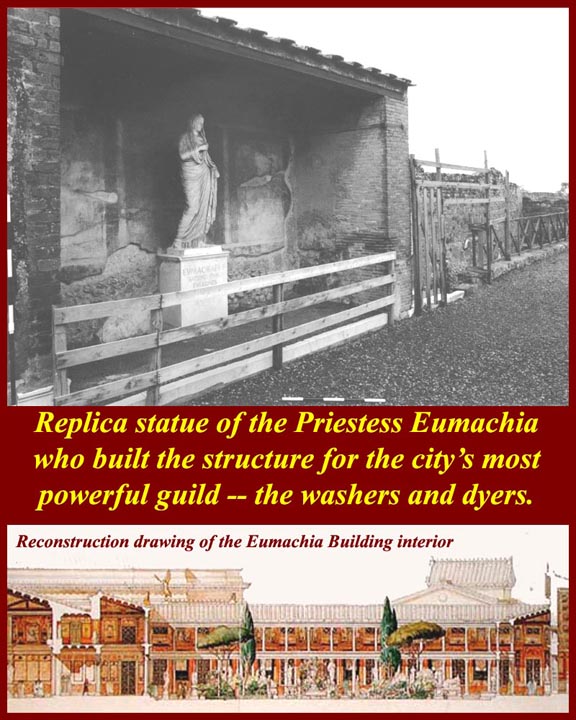
http://www.mmdtkw.org/ALRIVes0340Eumachia2.jpg
The fullers reciprocated by erecting a statue of Eumachia,
head veiled as a priestess, within the building. The
statue now standing in the Eumachia building is a replica, the
original having been taken to the National Archeological Museum
in Naples to protect it from tourists and the elements.
The dedicatory inscription reads:
"To Eumachia, daughter of
Lucius, public priestess, the fullers [dedicated this statue].
"
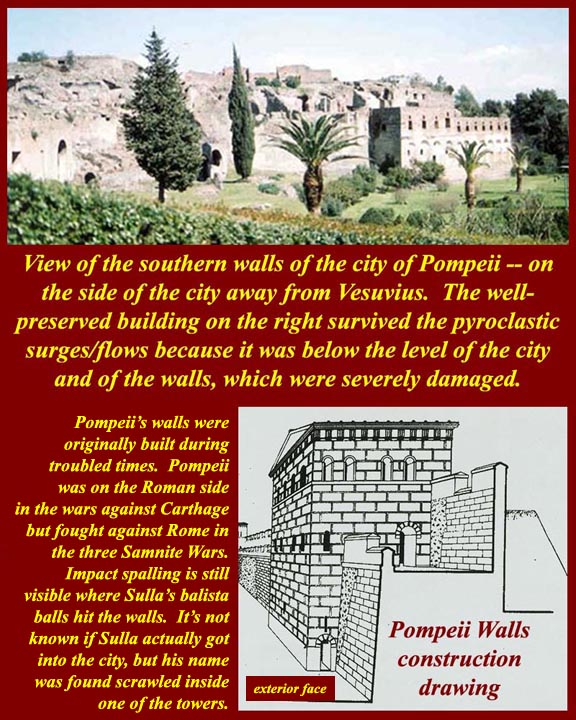
http://www.mmdtkw.org/ALRIVes0341PompeiiWalls.jpg
The southern wall of Pompeii. The southern edge of
Pompeii was on an old lava dike. The city and the walls on
the city on top of the dike were ravaged by the pyroclastic
surges/flows of the Peleean phase of the 79 AD eruption, but the
building below the southern edge of the dike survived almost
unscathed: the pyroclastic blasts simply blew right over
the top of it. It was, of course, completely buried by the
fallout. Pompeii was a walled city (even though Rome
was not, at this time) because Pompeii had been a military
colony in conquered territory for much of the preceding 150
years. Pompeii had been Samnite (part of the Oscan
linguistic group), and the Samnites had fought in three civil
wars against Rome. Sulla finally defeated them in 80 BC
and founded a military colony dedicated to Venus. By the
time of the eruption, Pompeii had been thoroughly integrated
under Roman control -- mostly by population replacement -- and
had achieved the legal status of civitas. Nonetheless, the walls
remained. A precis on the various occupation levels of the
area around Pompeii/Herculanum is on the Internet at https://slidetodoc.com/cities-of-vesuviuspompeii-and-herculaneum-stages-of-occupation/.
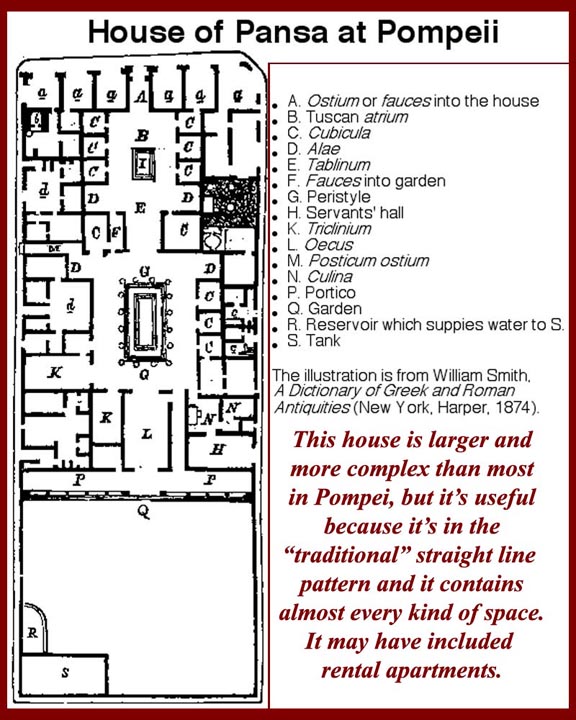
http://www.mmdtkw.org/ALRIVes0342PansaPompeii.jpg
The Pansa House follows the standard linear plan of a
large Roman "atrium domus". The plan in the image shows
just about every kind of room and use of space that you might
find in a domus. A large percentage of Pompeii's
population lived in much less opulent surroundings, but it is in
this type of house that most of the artwork -- frescoes,
mosaics, statuary, plate, jewelry, etc. -- have been
found: rich folks, by definition and as always, had more
riches. The size of Roman households (or "housefulls") is
much disputed. It's clear that some houses had separate
apartments -- you just have to count the lararia, altars to
household gods -- but it's not known whether the apartment
inhabitants were renters, relatives, freedmen, permanent guests,
potential adoptees, foreign hostages, or members of several
other possible groups. Archeological folks and academics,
especially doctoral candidates looking for a Pompeiian topic,
argue about this kind of thing a lot.
http://www.m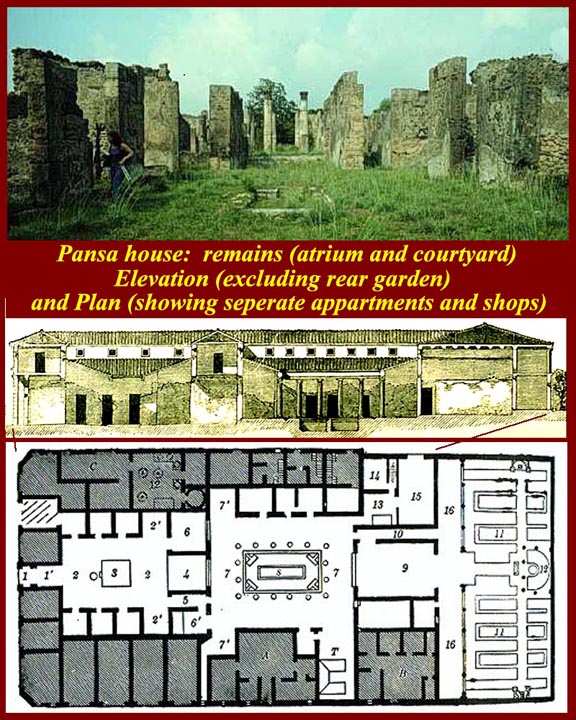 mdtkw.org/ALRIVes0343PansaRemains.jpg
mdtkw.org/ALRIVes0343PansaRemains.jpg
Ruins of the Pansa House, a proposed side elevation, and
another plan showing first floor shops and apartments
surrounding the central, presumably owner's, large central
suite. Disputes also still rage over whether there may
have been separate additional apartments on the second floor of
this and other similar large houses. Few buildings
retained their upper floors. Ash fall protected most
ground floor from pyroclastic surges and flows, but anything
that stood above the level of the ash took the full force of the
Peleean blasts.
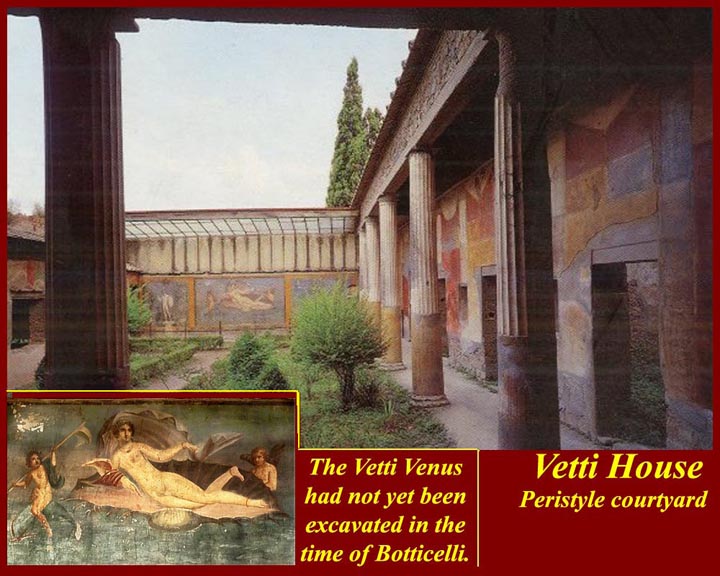
http://www.mmdtkw.org/ALRIVes0344Vetti1.jpg
Shown
in this picture is the famous "replica garden".
The ash from Vesuvius fell so quickly and settled so
rapidly that the flowers in the original garden left
their impressions in the ash. When these were filled in
and then examined, botanists were able to determine
which flowers were planted. Workers today try to
make the area an exact replica of the garden the Vetti
had almost 2,000 years ago.
The Vetti house (domus) got its name from the two gold rings
found there, each of which was inscribed with the name of a
Vetti brother. The house was perhaps the most lavishly
decorated house inside the walls of Pompeii: comparable
decoration is available at several suburban and coastal villas
also buried by the 79 AD eruption. "Venus on the
half-shell" was a fairly common motif in Roman art, but the
Vetti Venus is particularly good. Botticelli never saw
this particular girl -- it still lay buried in his time -- but
you would never know that by looking at them. The
Bottiicelli version is available all over the Internet, with a
fine version at http://www.artchive.com/artchive/b/botticelli/venus.jpg.
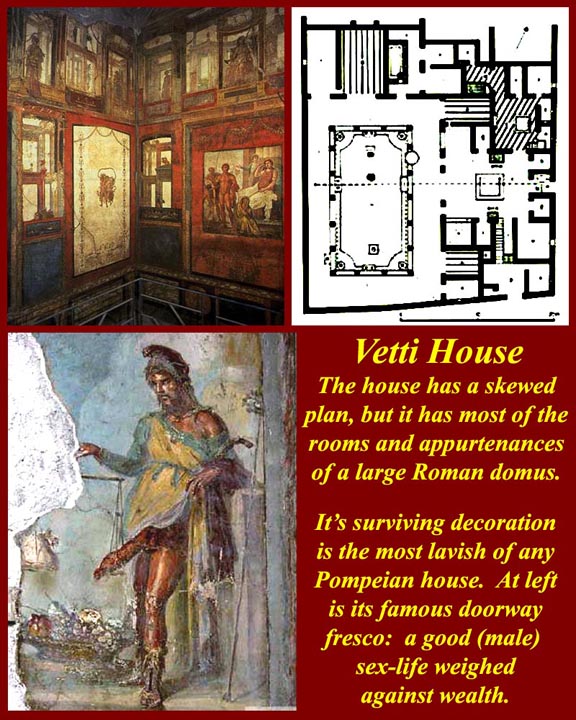
http://www.mmdtkw.org/ALRIVes0345Vetti2.jpg
Rich they must have been and upper-class, but not exactly
what we would call "high class". The effect of all the elegant
art inside is spoiled for modern visitors by the tacky fresco of
Priapis to the left of the front door. He is shown
weighing his enormous organ against a bag of gold -- a
comparison of the advantage of wealth over a good (male)
sex-life.
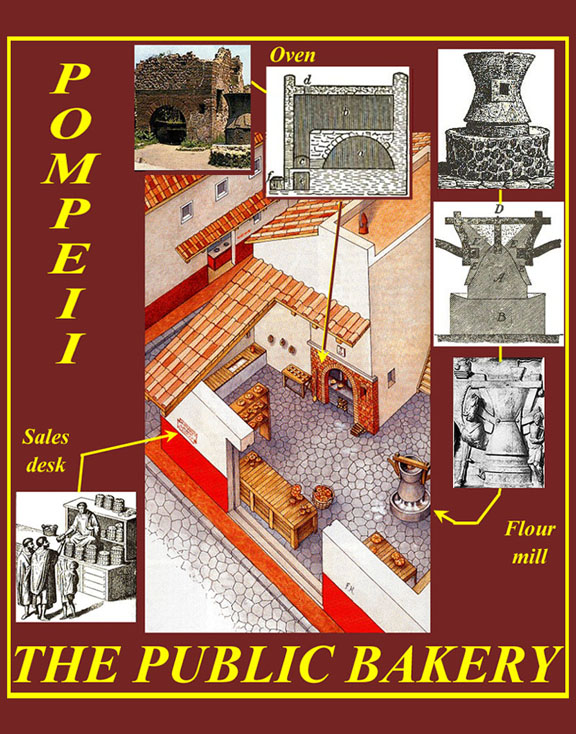
http://www.mmdtkw.org/ALRIVes0346Bakery.jpg
One of the most photographed bakeries in the world has
produced no bread for almost two thousand years. Roman
bakeries often were "vertically integrated": they did
everything from milling the grain to retail selling of baked
products. This was done because the food dole, to which
everyone was entitled, was distributed in the form of unground
wheat imported from Egypt and North Africa. The line,
"Give us this day our daily bread", would have been clearly
understood in early Christianity as a reference to the grain
dole, and, in fact, the Christian cult took over food
distribution from the time of Pope Gregory I ("the Great"), who
was a high ranking civic official in Rome before he left
society, became a monk, and was elected pope. The
characteristic Pompeian (volcanic tufa) millstone was a local
product and was often reproduced for export to other parts of
the Roman world. A higher resolution version of Mau's
drawing of a Pompeian flour mill is available on the Internet
at http://www.gutenberg.org/dirs/9/6/2/9628/9628-h/images/22.jpg.
A
drawing of a much larger 4th century Roman industrial flour at
Barbegal near Arles, France, is on the internet at http://www.mmdtkw.org/03-04BarbegalMill.jpg.
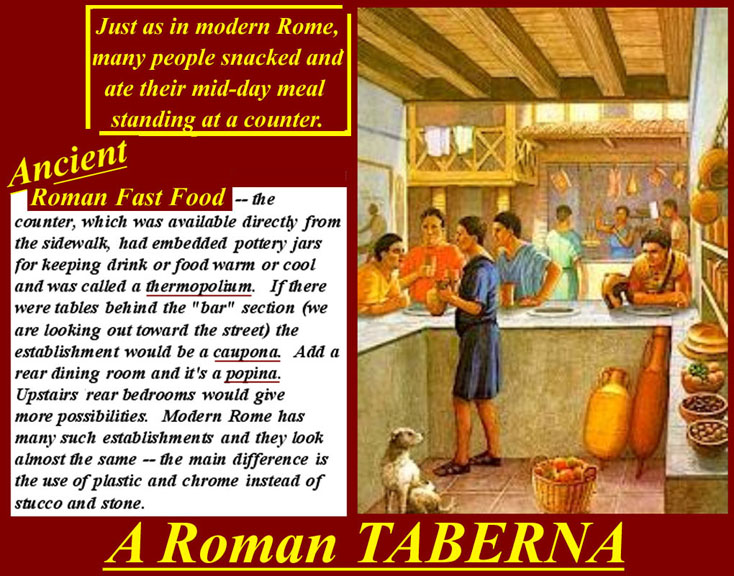
http://www.mmdtkw.org/ALRIVes0347Taberna.jpg
Only the largest houses had their own kitchens:
everyone else either ate out or had carry-out. Even the
rich often ate "fast food" during the day at a local taberna, and might
hire caterers to bring in large meals. The taberna tradition
survives today in Italy with the tavole calde (hot
tables) that sell everything from individual meals to
family-size take-out to catered banquets. Other
Mediterranean cultures have similar establishments.
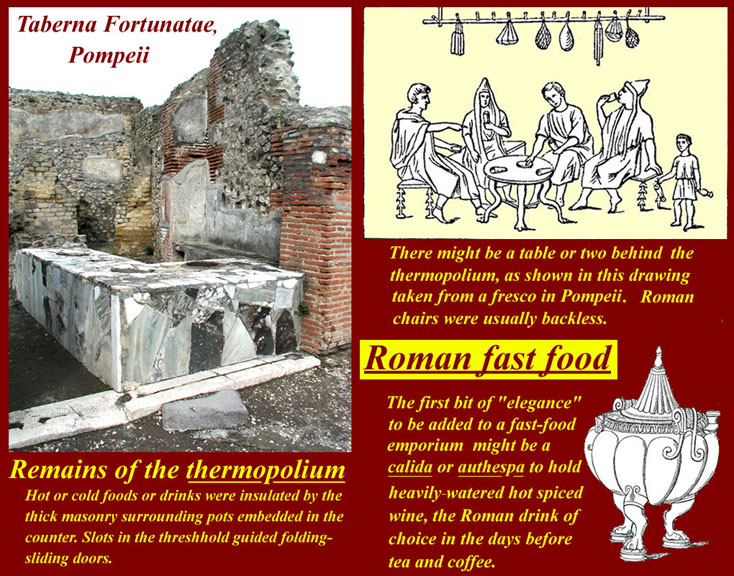
http://www.mmdtkw.org/ALRIVes0348TabernaFortunatae.JPG
The name of the Taberna Fortunatae was easy to
determine: archeologists found the name over the
door. Hot and cold foods were dispensed at the counter,
which had embedded terra
cotta jar, insulated by surrounding
masonry. Samovar-type liquid dispensers usually held hot
spiced wine: Italy had not yet discovered the coffee
habit.
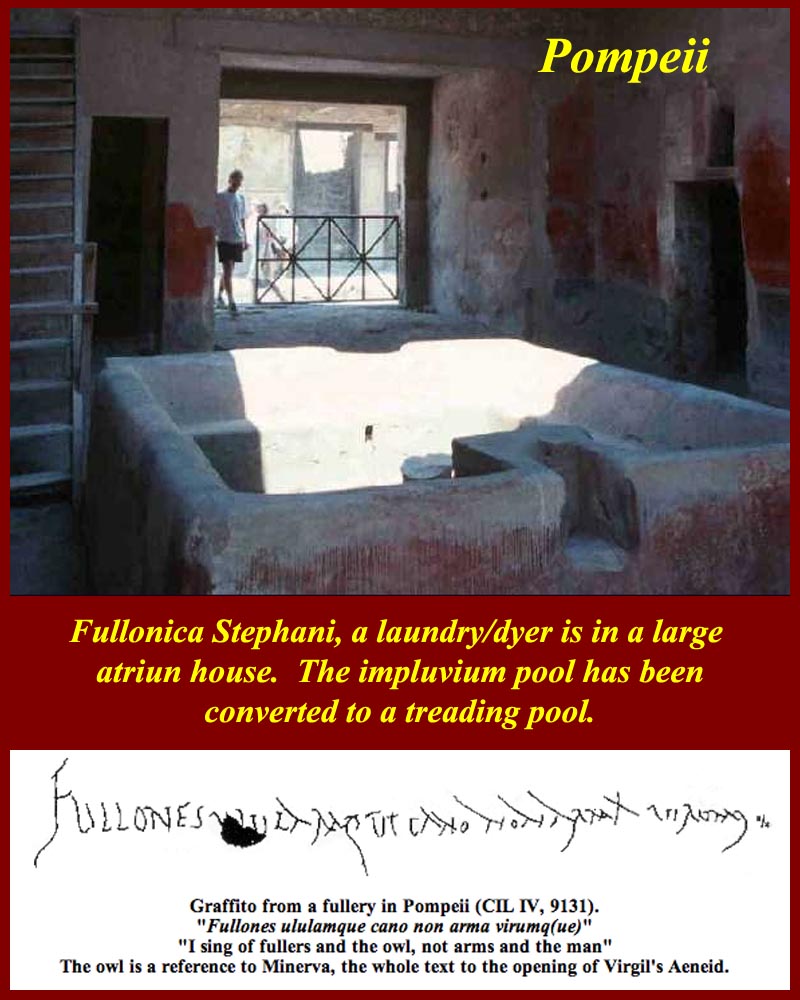
http://www.mmdtkw.org/ALRIVes0349FullonStephani.jpg
Pompeii's cleaning, dying, and fabric industry was, as
mentioned above, a mainstay of the Pompeian economy.
Fullonica Stephani re-used a large atrium house: a large
vat, in which clothing was washed, occupied the center of the
former atrium. It was built on top of the impluvium, the pool
that captured rainwater that drained from the inward-sloping
roof of the atrium. Some fullonicae processes used human urine
(collected in streetcorner pots), but it's not known what was in
the atrium vat. The Stephani fullonica was by no
means Pompeii's largest: its fame is really associated with the
fact of its reuse of a former plush residence. It is
assumed that the proprietors occupied the rest of the
domus. The graffito,
found in a Pompeii fullonica, is a parody of the opening line of
Virgil's Aeneid: it sings "of fullers and the owl" rather than
"arms and the man". The graffito reference to "the owl" is most
often associated with Minerva (Athena) a patron goddess of the
fullers, but the word used, ulula, is the Screech Owl, and it may
refer to the noise level of the work environment. Some
15,000 graffiti of various levels of grammar, painting skill,
and cultural antecedents (Vergil!) have been catalogued in
Pompeii and Herculaneum.
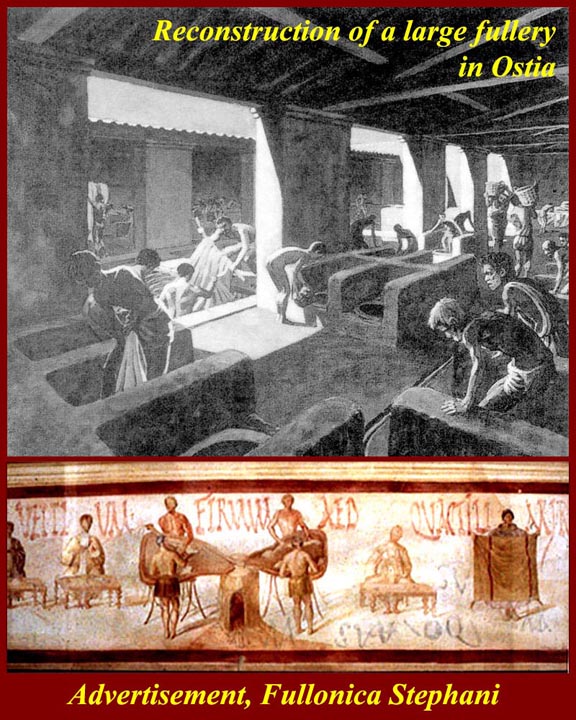
http://www.mmdtkw.org/ALRIVes0350Fullonica.jpg
The upper part of this image is an artist's reconstruction
of a large fullonica in Ostia, Rome's seaport at the mouth of
the Tiber River. We know what fullonicae looked
like because of advertising such as that shown in the Pompeii
fresco in the lower part of the image. The Ostia
fullonica picture and the graffito in the previous image are
from
http://www.ostia-antica.org/dict/topics/fullones/intro.htm
on the Internet.
_____________________________________
New excavations in Area V of Pompeii





































































 mdtkw.org/ALRIVes0343PansaRemains.jpg
mdtkw.org/ALRIVes0343PansaRemains.jpg




